Paul van Yperen's Blog, page 341
July 1, 2016
Gérard Philipe
Gérard Philipe (1922–1959) played the artist Amedeo Modigliani in Montparnasse 19/The Lovers of Montparnasse (1958), one of the highlights of JACQUES BECKER – THE VERY IDEA OF FREEDOM at Cinema Ritrovata 2016. Philipe was adored for his good looks, but he was also a very talented actor. He was sought out by France's preeminent directors for his versatility and professionalism. His early death has elevated him to a near legendary status in France.
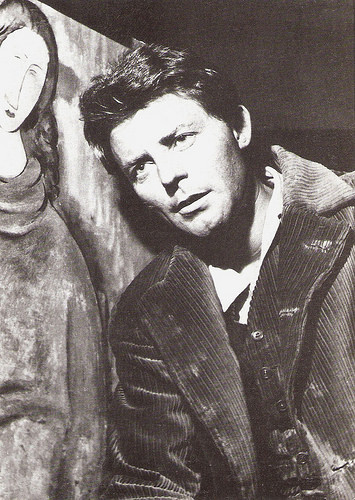
French postcard by Sofraneme, Levallois Perret no. CP 210. Photo: publicity still for Les amants de Montparnasse/The Lovers of Montparnasse (Jean Becker, 1958) with Gérard Philipe as painter Amedeo Modigliani.
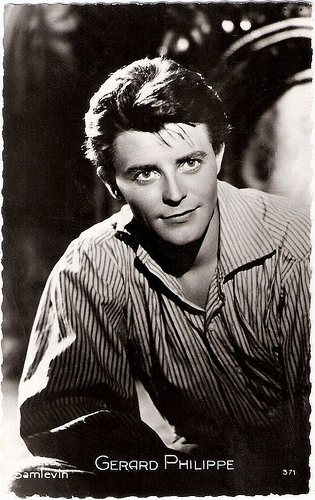
French Postcard by Editions P.I., Paris, no. 371. Photo: Sam Lévin.
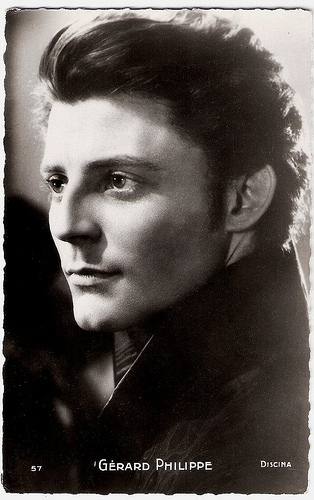
French postcard by Editions P.I., Paris, no. 57. Photo: Discina.
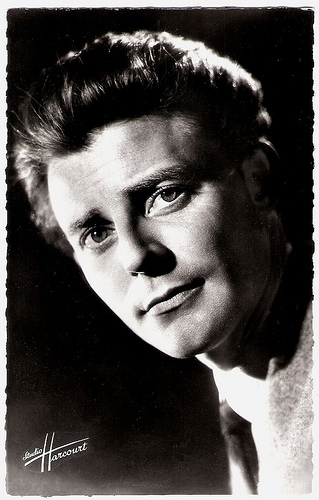
French postcard by Editions du Globe, Paris. Photo: Studio Harcourt.
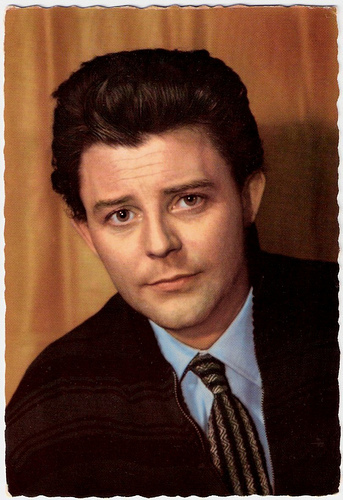
German postcard by Universum-Film Aktiengesellschaft (UFA), Berlin-Tempelhof, no. 1041. Photo: UFA.
Rave Reviews
Gérard Philipe (sometimes written as Philippe) was born Gérard Philip in Cannes, France in 1922. In 1940, Gérard left school and his parents wanted him to become a lawyer. His mother noticed that he was only interested in acting, but his father was against the idea.
Gérard's father, a successful businessman, was a right-wing extremist and colloborated with the Nazis. After the war, he was forced to exile to Spain to escape a death sentence. Gérard himself was his whole life a staunch social liberal politically-wise.
Actor Claude Dauphin introduced the young Philippe in 1942 to the stage. One of his first parts was as the angel in Sodome et Gomorrhe by Jean Giraudoux in 1943.
Director Marc Allégret decided that the he showed some promise and gave him a small part in his film Les petites du quai aux fleurs/The Girls From the Quai aux Fleurs (Marc Allégret, 1944) starring Odette Joyeux .
With the support of his admirer Jean Cocteau, he entered the Paris Conservatory where, under the tutelage of Georges Le Roy he discovered his passion for live theatre. In 1945 he received rave reviews for his performance in the stage production of Albert Camus’ Caligula.
This success further opened the doors to the cinema. His first leading part in Le pays sans étoiles/Land Without Stars (Georges Lacombe, 1946) opposite Jany Holt got so many favourable reviews that he became a star.
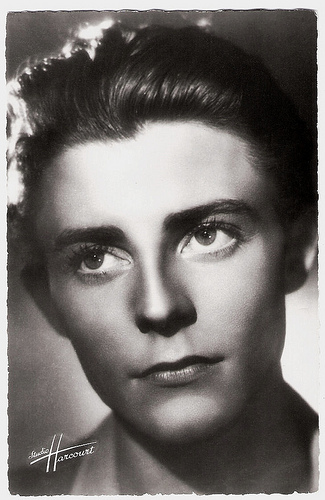
French postcard by Editions du Globe, no. 22. Photo: Studio Harcourt.
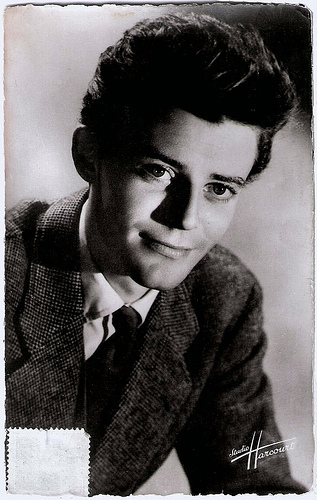
French postcard by Editions du Globe (E.D.U.G.), Paris, no. 31. Photo: Studio Harcourt.
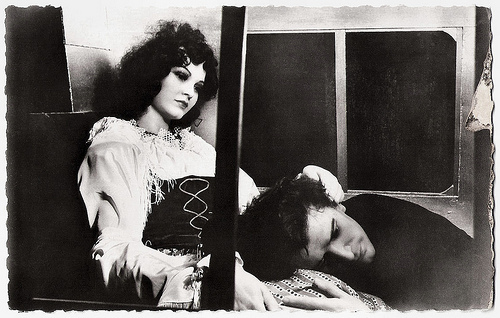
French postcard by Editions P.I. / Editions du Musée Grévin., Paris, no. 4. Publicity still for La Beauté du diable/Beauty and the Devil (René Clair, 1950) with Nicole Besnard. Captions: Voyage de noces a Venise (Honeymoon in Venice).
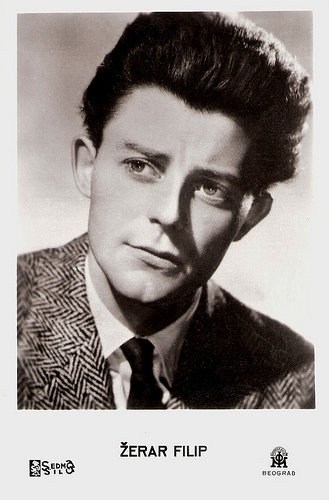
Serbian postcard by Sedm Sil.
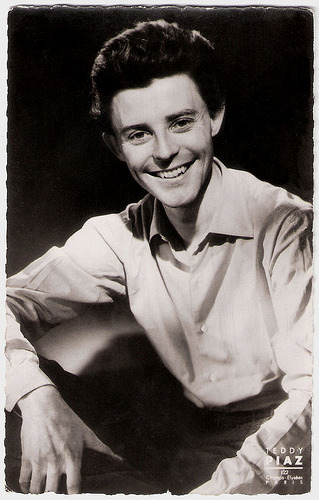
French postcard by Editions du Globe, no. 51. Photo: Teddy Piaz, Paris.
Tongue-in-cheek Titular Swashbuckler
In 1947, Gérard Philipe exploded upon the European film scene in Le diable au corps/Devil in the Flesh (Claude Autant-Lara, 1947), playing Francois Jaubert, a callow youth in love with much-older and very married Micheline Presle .
Superstardom followed almost immediately: female filmgoers doted upon Philippe's sensitive, handsome features and strapping physique, while men identified with his soulfulness and introspection. Next he would take on prominent roles in such classic films as Une si jolie petite plage/Such a Pretty Little Beach (Yves Allégret, 1949), and La beauté du diable/Beauty and the Devil (René Clair, 1950) as Faust.
He was an international success as the tongue-in-cheek titular swashbuckler Fanfan la Tulipe/Fan-Fan the Tulip (Christian-Jaque, 1952), one of the most popular historical-adventure films made in France.
At Films de France , James Travers reviews: "Not only is the film impeccably made, with lavish production values, stunning cinematography and impressively choreographed fight scenes, but it has a timeless quality which will no doubt ensure it will remain a popular classic for years to come. Philipe excels in this film in what is regarded by many as his finest film role, the indefatiguable womaniser and agile swordsman Fanfan la Tulipe. Philipe is simply brilliant in the role, tackling the numerous swordfights and Henri Jeanson’s sparkling dialogue with equal relish."
He appeared with such great stars of the European cinema as Italian beauty Gina Lollobrigida in Les belles de nuit/Beauties of the Night (René Clair, 1952), with Michèle Morgan in both Les orgueilleux/The Proud Ones (Yves Allégret, 1953) and Les grandes manœuvres/The Grand Maneuver (René Clair, 1955).
In 1956, Philipe starred in and directed a filmization of the old folk tale Till Eulenspiegel, Les aventures de Till L'Espiègle/Bold Adventure (Gérard Philipe, Joris Ivens, 1956). The French-East-German coproduction was not a success. He simultaneously pursued his stage career, with a keen involvement in the Théatre National de Paris, which would endure up until his death. Whilst working at the TNP, Philipe, a strong believer in egalitarianism, would draw exactly the same salary as junior actors. He would also become president of the French actors union, actively promoting the rights of actors.
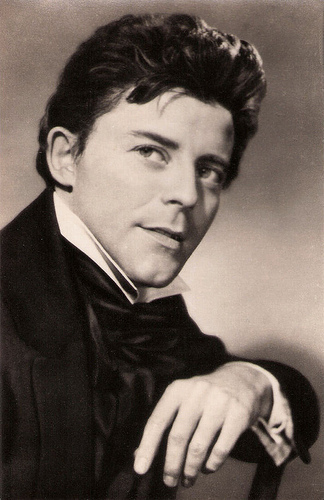
East-German postcard by VEB Progress Film-Vertrieb, Berlin, no. 73. Photo: Franco-London-Film S.A. Publicity still for Le rouge et le noir/The Red and the Black (Claude Autant-Lara, 1954).
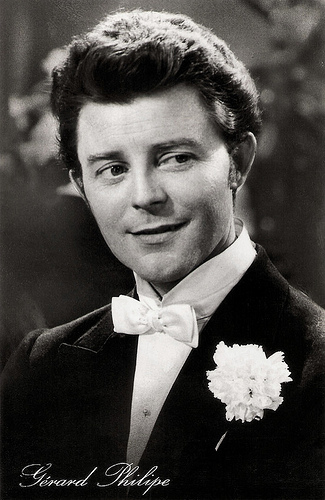
East-German postcard by VEB Progress Filmvertrieb, no. 1290, 1960. Photo: publicity still for Pot-Bouille/Lovers of Paris (Julien Duvivier, 1957).
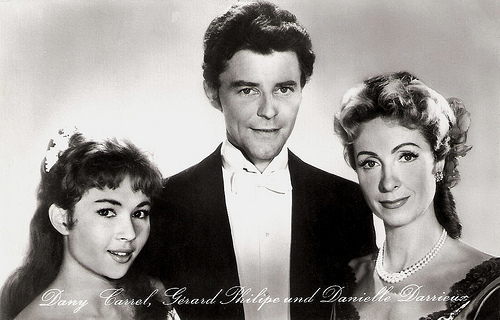
East-German postcard by VEB Progress Filmvertrieb, no. 1294, 1960. Photo: publicity still for Pot-Bouille/Lovers of Paris (Julien Duvivier, 1957) with Dany Carrel and Danielle Darrieux .
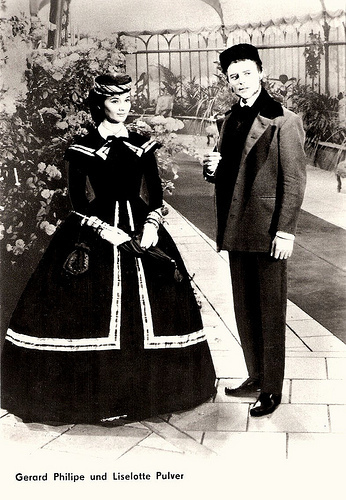
East-German postcard by VEB Progress Film-Vertrieb, no. 2699. Retail price: 0,20 MDN. Photo: publicity still for Le joueur/The Gambler (Claude Autant-Lara, 1958) with Liselotte Pulver .
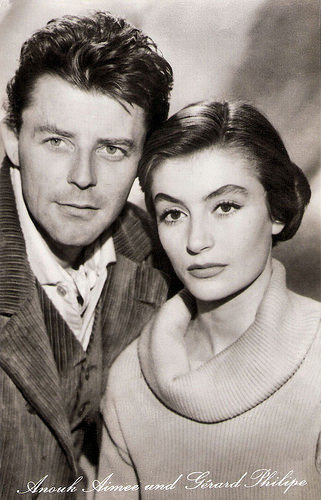
East-German postcard by VEB Progress Filmvertrieb, Berlin no. 1272, 1960. Photo: publicity still for Les amants de Montparnasse/The Lovers of Montparnasse (Jacques Becker, 1958) with Anouk Aimée .
Legendary Status
Gérard Philipe continued his string of film successes throughout the 1950s. Among these films were the Fyodor Dostoevsky adaptation Le joueur/The Gambler (Claude Autant-Lara, 1958) with Liselotte Pulver , and Les liaisons dangereuses/Dangerous Liaisons (Roger Vadim, 1959) opposite Jeanne Moreau .
In 1959 doctors told Philippe that he had liver cancer. On 25 November that year, while working on Luis Buñuel's Le Fievre Monte a El Pao/Fever Mounts at El Pao (Luis Buñuel, 1959), he died at the peak of his popularity. He was just 36 years old.
The news provoked an immediate and intense out-pouring of grief. His early death elevated him to a near legendary status in France. Since 1951, Philipe was married to actress and writer Nicole Fourcade, with whom he had two children, writer and actor Anne-Marie Philipe (1954) and Olivier Philipe (1957).
Nicole adopted the pseudonym Anne Philipe, and wrote two books about her husband, Souvenirs (1960) and Le Temps d'un soupir (1963, No Longer Than a Sigh). In 1961, Gérard's portrait appeared on a French commemorative postage stamp. There is a film festival named in his honor as well as a number of theaters, schools and colleges in various parts of France. He was also very popular in Germany, and a Berlin theatre has been named after him.
Trailer for La Beauté du diable/Beauty and the Devil (René Clair, 1950). Source: entertainmentone (YouTube).
French trailer for Les belles de nuit/Beauties of the Night (1952). Source: Imineo (YouTube).
Trailer for Fanfan la Tulipe/Fan-Fan the Tulip (Christian-Jaque, 1952). Source: Retrotrailer (YouTube).
Compilation of scenes from Les grandes manœuvres/The Grand Maneuver (1955). Source: Slava Batareykin (YouTube).
French trailer for Les amants de Montparnasse/The Lovers of Montparnasse (Jacques Becker, 1958). Source: Gaumont (YouTube).
Sources: James Travers (Le Film Guide), AllMovie, Films de France, Wikipedia, and .

French postcard by Sofraneme, Levallois Perret no. CP 210. Photo: publicity still for Les amants de Montparnasse/The Lovers of Montparnasse (Jean Becker, 1958) with Gérard Philipe as painter Amedeo Modigliani.

French Postcard by Editions P.I., Paris, no. 371. Photo: Sam Lévin.

French postcard by Editions P.I., Paris, no. 57. Photo: Discina.

French postcard by Editions du Globe, Paris. Photo: Studio Harcourt.

German postcard by Universum-Film Aktiengesellschaft (UFA), Berlin-Tempelhof, no. 1041. Photo: UFA.
Rave Reviews
Gérard Philipe (sometimes written as Philippe) was born Gérard Philip in Cannes, France in 1922. In 1940, Gérard left school and his parents wanted him to become a lawyer. His mother noticed that he was only interested in acting, but his father was against the idea.
Gérard's father, a successful businessman, was a right-wing extremist and colloborated with the Nazis. After the war, he was forced to exile to Spain to escape a death sentence. Gérard himself was his whole life a staunch social liberal politically-wise.
Actor Claude Dauphin introduced the young Philippe in 1942 to the stage. One of his first parts was as the angel in Sodome et Gomorrhe by Jean Giraudoux in 1943.
Director Marc Allégret decided that the he showed some promise and gave him a small part in his film Les petites du quai aux fleurs/The Girls From the Quai aux Fleurs (Marc Allégret, 1944) starring Odette Joyeux .
With the support of his admirer Jean Cocteau, he entered the Paris Conservatory where, under the tutelage of Georges Le Roy he discovered his passion for live theatre. In 1945 he received rave reviews for his performance in the stage production of Albert Camus’ Caligula.
This success further opened the doors to the cinema. His first leading part in Le pays sans étoiles/Land Without Stars (Georges Lacombe, 1946) opposite Jany Holt got so many favourable reviews that he became a star.

French postcard by Editions du Globe, no. 22. Photo: Studio Harcourt.

French postcard by Editions du Globe (E.D.U.G.), Paris, no. 31. Photo: Studio Harcourt.

French postcard by Editions P.I. / Editions du Musée Grévin., Paris, no. 4. Publicity still for La Beauté du diable/Beauty and the Devil (René Clair, 1950) with Nicole Besnard. Captions: Voyage de noces a Venise (Honeymoon in Venice).

Serbian postcard by Sedm Sil.

French postcard by Editions du Globe, no. 51. Photo: Teddy Piaz, Paris.
Tongue-in-cheek Titular Swashbuckler
In 1947, Gérard Philipe exploded upon the European film scene in Le diable au corps/Devil in the Flesh (Claude Autant-Lara, 1947), playing Francois Jaubert, a callow youth in love with much-older and very married Micheline Presle .
Superstardom followed almost immediately: female filmgoers doted upon Philippe's sensitive, handsome features and strapping physique, while men identified with his soulfulness and introspection. Next he would take on prominent roles in such classic films as Une si jolie petite plage/Such a Pretty Little Beach (Yves Allégret, 1949), and La beauté du diable/Beauty and the Devil (René Clair, 1950) as Faust.
He was an international success as the tongue-in-cheek titular swashbuckler Fanfan la Tulipe/Fan-Fan the Tulip (Christian-Jaque, 1952), one of the most popular historical-adventure films made in France.
At Films de France , James Travers reviews: "Not only is the film impeccably made, with lavish production values, stunning cinematography and impressively choreographed fight scenes, but it has a timeless quality which will no doubt ensure it will remain a popular classic for years to come. Philipe excels in this film in what is regarded by many as his finest film role, the indefatiguable womaniser and agile swordsman Fanfan la Tulipe. Philipe is simply brilliant in the role, tackling the numerous swordfights and Henri Jeanson’s sparkling dialogue with equal relish."
He appeared with such great stars of the European cinema as Italian beauty Gina Lollobrigida in Les belles de nuit/Beauties of the Night (René Clair, 1952), with Michèle Morgan in both Les orgueilleux/The Proud Ones (Yves Allégret, 1953) and Les grandes manœuvres/The Grand Maneuver (René Clair, 1955).
In 1956, Philipe starred in and directed a filmization of the old folk tale Till Eulenspiegel, Les aventures de Till L'Espiègle/Bold Adventure (Gérard Philipe, Joris Ivens, 1956). The French-East-German coproduction was not a success. He simultaneously pursued his stage career, with a keen involvement in the Théatre National de Paris, which would endure up until his death. Whilst working at the TNP, Philipe, a strong believer in egalitarianism, would draw exactly the same salary as junior actors. He would also become president of the French actors union, actively promoting the rights of actors.

East-German postcard by VEB Progress Film-Vertrieb, Berlin, no. 73. Photo: Franco-London-Film S.A. Publicity still for Le rouge et le noir/The Red and the Black (Claude Autant-Lara, 1954).

East-German postcard by VEB Progress Filmvertrieb, no. 1290, 1960. Photo: publicity still for Pot-Bouille/Lovers of Paris (Julien Duvivier, 1957).

East-German postcard by VEB Progress Filmvertrieb, no. 1294, 1960. Photo: publicity still for Pot-Bouille/Lovers of Paris (Julien Duvivier, 1957) with Dany Carrel and Danielle Darrieux .

East-German postcard by VEB Progress Film-Vertrieb, no. 2699. Retail price: 0,20 MDN. Photo: publicity still for Le joueur/The Gambler (Claude Autant-Lara, 1958) with Liselotte Pulver .

East-German postcard by VEB Progress Filmvertrieb, Berlin no. 1272, 1960. Photo: publicity still for Les amants de Montparnasse/The Lovers of Montparnasse (Jacques Becker, 1958) with Anouk Aimée .
Legendary Status
Gérard Philipe continued his string of film successes throughout the 1950s. Among these films were the Fyodor Dostoevsky adaptation Le joueur/The Gambler (Claude Autant-Lara, 1958) with Liselotte Pulver , and Les liaisons dangereuses/Dangerous Liaisons (Roger Vadim, 1959) opposite Jeanne Moreau .
In 1959 doctors told Philippe that he had liver cancer. On 25 November that year, while working on Luis Buñuel's Le Fievre Monte a El Pao/Fever Mounts at El Pao (Luis Buñuel, 1959), he died at the peak of his popularity. He was just 36 years old.
The news provoked an immediate and intense out-pouring of grief. His early death elevated him to a near legendary status in France. Since 1951, Philipe was married to actress and writer Nicole Fourcade, with whom he had two children, writer and actor Anne-Marie Philipe (1954) and Olivier Philipe (1957).
Nicole adopted the pseudonym Anne Philipe, and wrote two books about her husband, Souvenirs (1960) and Le Temps d'un soupir (1963, No Longer Than a Sigh). In 1961, Gérard's portrait appeared on a French commemorative postage stamp. There is a film festival named in his honor as well as a number of theaters, schools and colleges in various parts of France. He was also very popular in Germany, and a Berlin theatre has been named after him.
Trailer for La Beauté du diable/Beauty and the Devil (René Clair, 1950). Source: entertainmentone (YouTube).
French trailer for Les belles de nuit/Beauties of the Night (1952). Source: Imineo (YouTube).
Trailer for Fanfan la Tulipe/Fan-Fan the Tulip (Christian-Jaque, 1952). Source: Retrotrailer (YouTube).
Compilation of scenes from Les grandes manœuvres/The Grand Maneuver (1955). Source: Slava Batareykin (YouTube).
French trailer for Les amants de Montparnasse/The Lovers of Montparnasse (Jacques Becker, 1958). Source: Gaumont (YouTube).
Sources: James Travers (Le Film Guide), AllMovie, Films de France, Wikipedia, and .
Published on July 01, 2016 22:00
June 30, 2016
EFSP's Dazzling Dozen: Rediscovering Great Faces at Cinema Ritrovato 2016
This week our blog is dedicated to the Cinema Ritrovata 2016 festival in Bologna, Italy. We are getting high on the great films from all periods of the cinematic history, found in archives all over the world. For Postcard Friendship Friday, we chose twelve postcards of stars who can be (re)discovered here at one of the five festival screens.
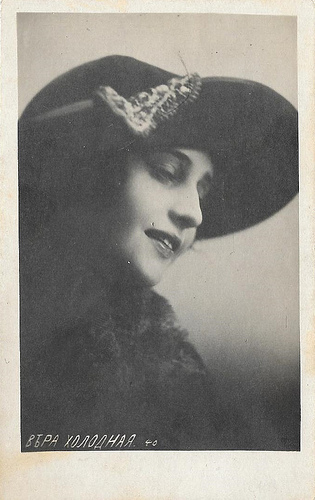
Vera Kholodnaya . Russian postcard, no. 40. Collection: Didier Hanson.
Kholodnaya is the star of Zhizn za zhizn/A Life for a Life (Yevgeni Bauer, 1916), shown in the section '100 Years Ago: A Selection of 1916'.
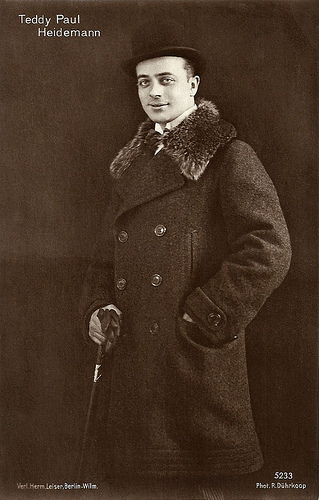
Paul Heidemann . German postcard by Verlag Hermann Leiser, Berlin-Wilm., no. 5233. Photo: R. Dührkoop.
Comedian Paul Heidemann can be seen in the same section in the crazy comedy Die Entdeckung Deutschlands durch die Marsbewohner/The Discovery of Germany by the Martians (Otto Frankfurter, Georg Jacoby, 1916).
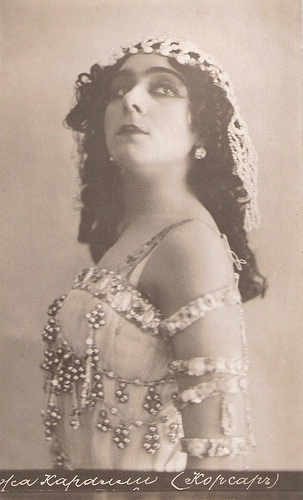
Vera Karalli . Russian postcard.
Karalli is the star of another pre-Soviet film of 100 years ago, Umirajuščij lebed’/The Dying Swan (Yevgeni Bauer, 1916).
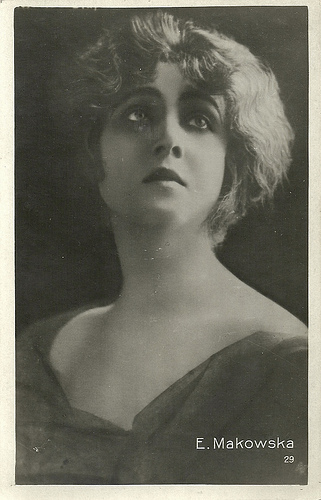
Elena Makowska . Italian postcard, no. 29.
Newly preserved by the archives of Turin and Bologna is an incomplete version of La Diacola sotto il moggio (Eleuterio Rodolfi, 1916), starring Polish-born diva (H) Elena Makowska . Presented in '100 Years Ago: A Selection of 1916'.
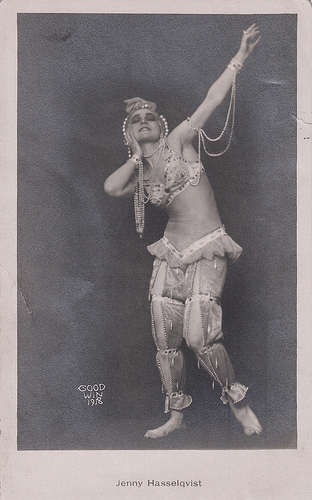
Jenny Hasselqvist . Vintage postcard. Photo: Henry B. Goodwin, 1918. Collection: Marlène Pilaete.
Another highlight from 1916 is the Swedish film Balletprimadonnan (Mauritz Stiller, 1916), featuring La Hasselqvist. A new preservation is shown.
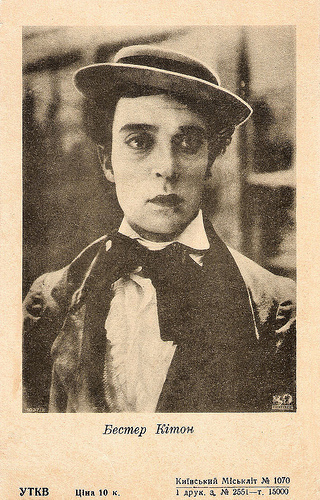
Buster Keaton . Soviet postcard, no. 1070. Photo: Phoebus Film (Probably the Ross Verlag card, no. 1037/2, was used for this card, produced in Kiev, now Ukraine). Publicity still for Our Hospitality (1923).
The Keaton Project, officially launched in 2015, continues at Cinema Ritrovato 2016. Our Hospitality is not presented this year, but we simply love to share this newly acquired postcard.
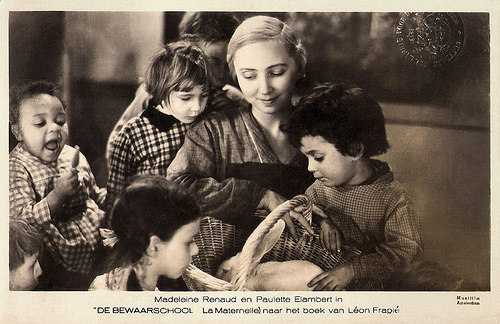
Madeleine Renaud and Paulette Elambert in La Maternelle (1933). Dutch postcard by M.B.&Z., no. 75. Photo: Muntfilm, Amsterdam. Publicity still for La Maternelle/Children of Montmartre (Jean Benoît-Lévy, Marie Epstein, 1933).
Marie Epstein, subject of 'Marie Epstein: cinéaste', was the screenwriter and co-director of at least four of her brother Jean Epstein’s silent films. In 1928 she and Jean Benoît-Lévy began directing poetic films on social issues that placed emphasis on the expressive power of amateur actors and young protagonists. Masterpieces like La Maternelle combined the objectivity of documentaries and the deep emotions evoked by Epstein’s screenplays.
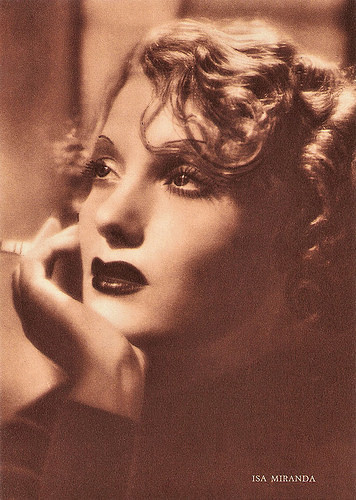
Isa Miranda . Italian postcard by Rizzoli, Milano, 1937-XV.
Miranda was the glamorous star of Malombra (1942), directed by brilliant and multi-faceted writer, director, and television pioneer Mario Soldati, one of the most inventive figures of 20th-century Italy and subject of the section 'Mario Soldati, an eclectic man at Cinécitta'.
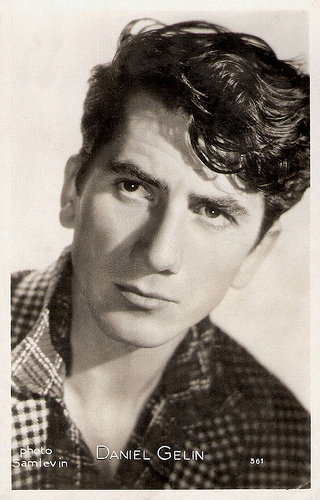
Daniel Gélin . French postcard by Editions P.I., Paris, no. 361. Photo: Sam Levin.
Arguably the most important section of this Cinema Ritrovato is 'Jean Becker - The very Idea of Freedom'. Becker was the best liked and the most respected among the French filmmakers in the days of the ‘Tradition of Quality’. Gélin starred in his manifesto Rendez-vous de juillet/Rendezvous in July (1949) about young jazz-loving Parisians.
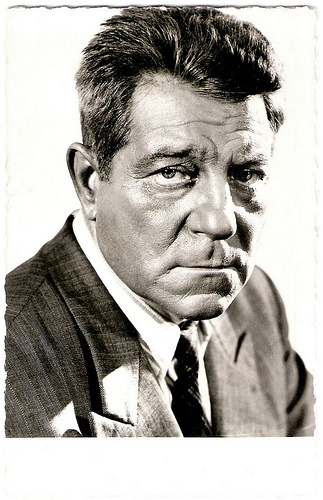
Jean Gabin . French postcard by Editions P.I., Paris, no. 1094. Offered by Les Carbones Korès 'Carboplane'. Photo: Marcel Bougureau.
Touchez pas au grisbi (Jean Becker, 1954) starring Jean Gabin is one of the greatest Film Noirs, ever.

East-German postcard by VEB Progress Film-Vertrieb, Berlin, no. 1842, 1963. Retail price: 0,20 DM. Publicity still for La liberté surveillée/Provisional Liberty (Henri Aisner, Vladimír Vlcek, 1958) with Marina Vlady and Robert Hossein .
La liberté surveillée/Provisional Liberty is shown in the section 'Marie Epstein: cinéaste'. Epstein was one of the writers of the screenplay. EFSP presents a film special about this unusual film next week, on 6 July 2016.
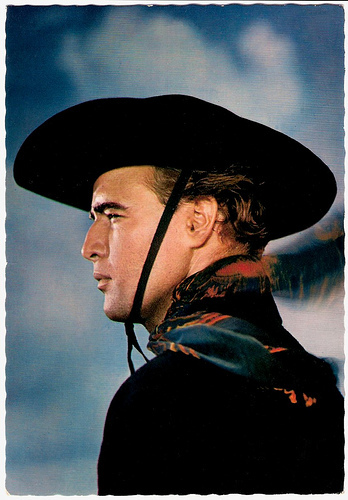
French postcard by EDUG, no. 133. Sent by mail in 1961. Photo: publicity still for One-Eyed Jacks (Marlon Brando, 1961) with Marlon Brando.
The pre-Leone Western One-Eyed Jacks is part of a 'Tribute to Marlon Brando' at Cinema Ritrovato. Brando, a monument of American cinema, became a legend the very moment he walked through the doors of the Actors Studio. He was the most virile and brazen of the three golden boys of his generation.
This is a post for Postcard Friendship Friday, hosted by Beth at the The Best Hearts are Crunchy. You can visit her by clicking on the button below.


Vera Kholodnaya . Russian postcard, no. 40. Collection: Didier Hanson.
Kholodnaya is the star of Zhizn za zhizn/A Life for a Life (Yevgeni Bauer, 1916), shown in the section '100 Years Ago: A Selection of 1916'.

Paul Heidemann . German postcard by Verlag Hermann Leiser, Berlin-Wilm., no. 5233. Photo: R. Dührkoop.
Comedian Paul Heidemann can be seen in the same section in the crazy comedy Die Entdeckung Deutschlands durch die Marsbewohner/The Discovery of Germany by the Martians (Otto Frankfurter, Georg Jacoby, 1916).

Vera Karalli . Russian postcard.
Karalli is the star of another pre-Soviet film of 100 years ago, Umirajuščij lebed’/The Dying Swan (Yevgeni Bauer, 1916).

Elena Makowska . Italian postcard, no. 29.
Newly preserved by the archives of Turin and Bologna is an incomplete version of La Diacola sotto il moggio (Eleuterio Rodolfi, 1916), starring Polish-born diva (H) Elena Makowska . Presented in '100 Years Ago: A Selection of 1916'.

Jenny Hasselqvist . Vintage postcard. Photo: Henry B. Goodwin, 1918. Collection: Marlène Pilaete.
Another highlight from 1916 is the Swedish film Balletprimadonnan (Mauritz Stiller, 1916), featuring La Hasselqvist. A new preservation is shown.

Buster Keaton . Soviet postcard, no. 1070. Photo: Phoebus Film (Probably the Ross Verlag card, no. 1037/2, was used for this card, produced in Kiev, now Ukraine). Publicity still for Our Hospitality (1923).
The Keaton Project, officially launched in 2015, continues at Cinema Ritrovato 2016. Our Hospitality is not presented this year, but we simply love to share this newly acquired postcard.

Madeleine Renaud and Paulette Elambert in La Maternelle (1933). Dutch postcard by M.B.&Z., no. 75. Photo: Muntfilm, Amsterdam. Publicity still for La Maternelle/Children of Montmartre (Jean Benoît-Lévy, Marie Epstein, 1933).
Marie Epstein, subject of 'Marie Epstein: cinéaste', was the screenwriter and co-director of at least four of her brother Jean Epstein’s silent films. In 1928 she and Jean Benoît-Lévy began directing poetic films on social issues that placed emphasis on the expressive power of amateur actors and young protagonists. Masterpieces like La Maternelle combined the objectivity of documentaries and the deep emotions evoked by Epstein’s screenplays.

Isa Miranda . Italian postcard by Rizzoli, Milano, 1937-XV.
Miranda was the glamorous star of Malombra (1942), directed by brilliant and multi-faceted writer, director, and television pioneer Mario Soldati, one of the most inventive figures of 20th-century Italy and subject of the section 'Mario Soldati, an eclectic man at Cinécitta'.

Daniel Gélin . French postcard by Editions P.I., Paris, no. 361. Photo: Sam Levin.
Arguably the most important section of this Cinema Ritrovato is 'Jean Becker - The very Idea of Freedom'. Becker was the best liked and the most respected among the French filmmakers in the days of the ‘Tradition of Quality’. Gélin starred in his manifesto Rendez-vous de juillet/Rendezvous in July (1949) about young jazz-loving Parisians.

Jean Gabin . French postcard by Editions P.I., Paris, no. 1094. Offered by Les Carbones Korès 'Carboplane'. Photo: Marcel Bougureau.
Touchez pas au grisbi (Jean Becker, 1954) starring Jean Gabin is one of the greatest Film Noirs, ever.

East-German postcard by VEB Progress Film-Vertrieb, Berlin, no. 1842, 1963. Retail price: 0,20 DM. Publicity still for La liberté surveillée/Provisional Liberty (Henri Aisner, Vladimír Vlcek, 1958) with Marina Vlady and Robert Hossein .
La liberté surveillée/Provisional Liberty is shown in the section 'Marie Epstein: cinéaste'. Epstein was one of the writers of the screenplay. EFSP presents a film special about this unusual film next week, on 6 July 2016.

French postcard by EDUG, no. 133. Sent by mail in 1961. Photo: publicity still for One-Eyed Jacks (Marlon Brando, 1961) with Marlon Brando.
The pre-Leone Western One-Eyed Jacks is part of a 'Tribute to Marlon Brando' at Cinema Ritrovato. Brando, a monument of American cinema, became a legend the very moment he walked through the doors of the Actors Studio. He was the most virile and brazen of the three golden boys of his generation.
This is a post for Postcard Friendship Friday, hosted by Beth at the The Best Hearts are Crunchy. You can visit her by clicking on the button below.

Published on June 30, 2016 22:00
June 29, 2016
Massimo Serato
At Cinema Ritrovata 2016, a programme section is focused on director MARIO SOLDATI, AN ECLECTIC MAN AT CINECITTÀ. He often worked with Massimo Serato (1916-1989), like for the historical drama Piccolo mondo antico/Little Old Fashioned World (Mario Soldati, 1941). The Italian film actor had a career spanning over 40 years with more than 140 films. Serato was the virile hero of dozens of Peplum films and Spaghetti Westerns in Italy, but he also played roles in major international films.
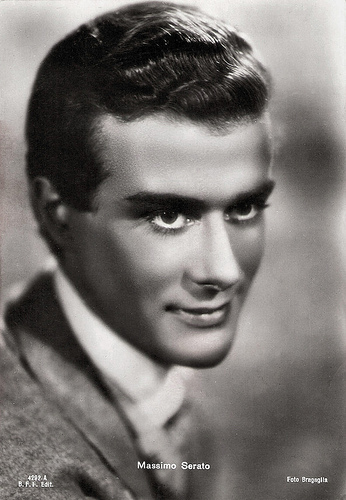
Italian postcard by B.F.F. Edit., no. 4242-A. Photo: Bragaglia.
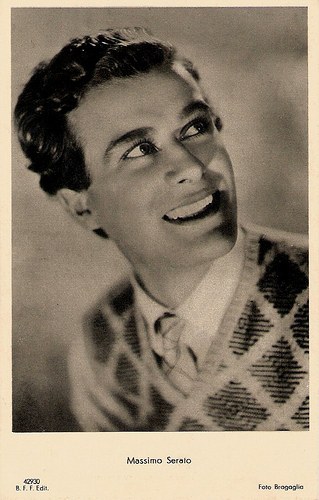
Italian postcard by B.F.F. Edit., no. 4293. Photo: Bragaglia.
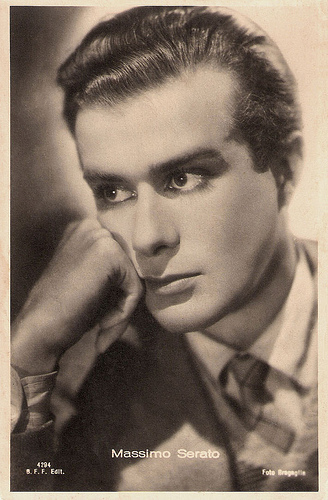
Italian postcard by B.F.F. Edit., no. 4294. Photo: Bragaglia.
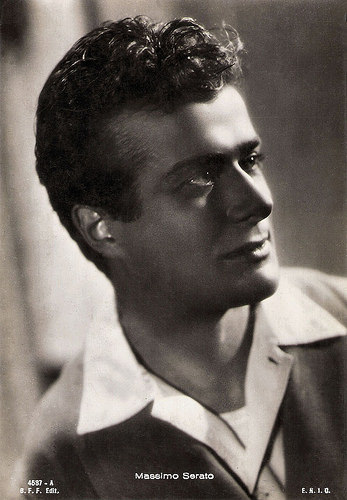
Italian postcard by B.F.F. Edit., no. 4587-A. Photo: E.N.I.C.
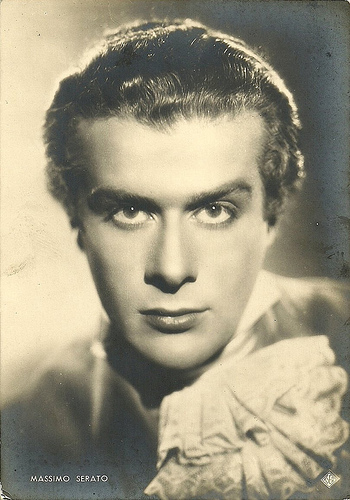
Italian postcard by A. Scarmaglia Ed. Roma (ASER). Photo: Ciolfi, Roma.
Tall, Blonde and Photogenic
Massimo Serato was born as Giuseppe Segato in 1916, in Oderzo, Italy. He abandoned his university studies, to attend the Centro Sperimentale, the Italian Film Academy in Rome.
He made his film debut in Inventiamo l'amore/Let’s Invent Love (Camillo Mastrocinque, 1938). His breakthrough was the historical drama Piccolo mondo antico/Little Old Fashioned World (Mario Soldati, 1941) with Alida Valli , about the Risorgimento, the unification of Italy.
From the early 1940s on, the tall, blonde and photogenic actor starred in films like L'uomo venuto dal mare/Man of the Sea (Belisario L. Randone, Roberto de Ribón, 1942), Giacomo l'idealista/Giacomo the Idealist (Alberto Lattuada, 1943), Le sorelle Materassi/The materassi Sisters (Ferdinando Maria Poggioli, 1944) and Quartieri alti/In High Places (Mario Soldati, 1943-1945).
After the war, he appeared in such Neorealist films like Il sole sorge ancora/Outcry (Aldo Vergano, 1946), Domenica D'Agosto/Sunday in August (Luciano Emmer, 1949) and the tragedy Febbre di vivere/Eager to Live (Claudio Gora, 1953) with Marina Berti .
He also appeared as the athletic hero in popular entertainment like La Traviata/The Lost One (Carmine Gallone, 1949) an adaptation of the opera of Giuseppe Verdi, the adventure Il Ladro di Venezia/The Thief of Venice (John Brahm, 1950) opposite Maria Montez in her last role, the historical drama Lucrece Borgia/Lucretia Borgia (Christian-Jacque, 1953) as the handsome lover of sex symbol Martine Carol , and L'Amante di Paride/The Loves of Three Queens (Marc Allégret, Edgar G. Ullmer, 1954) as one of the three loves of Hedy Lamarr .
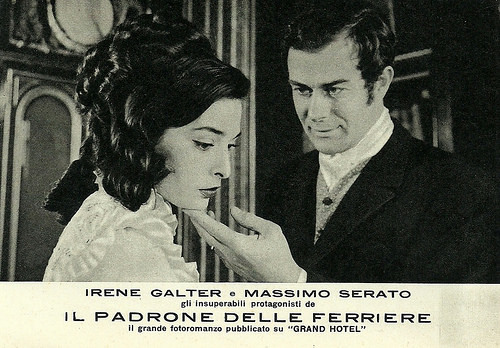
Italian postcard for the 'fotoromanzo' Il padrone delle ferriere, starring Massimo Serato and Irene Galter, published in 'Grand Hotel' in 1960. It was based on Georges Ohnet's famous novel Le maitre des forges.
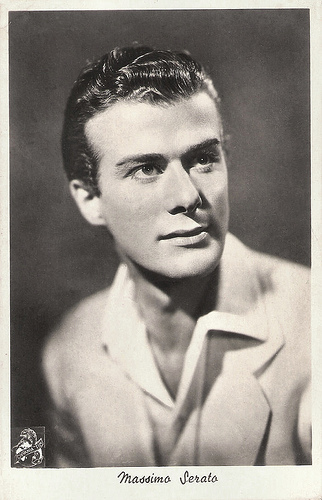
Italian postcard by Alterocca, Terni, no. 6617, 1941. Photo: Ferri / Sovrania Films.
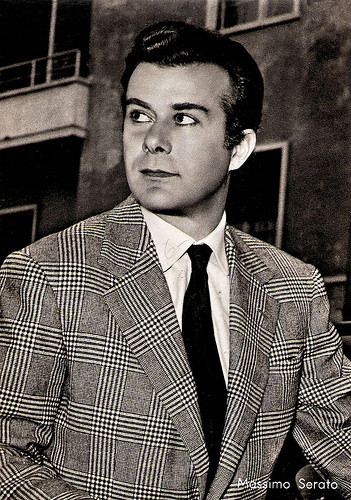
Italian postcard by Bromostampa, Milano, no. 145.
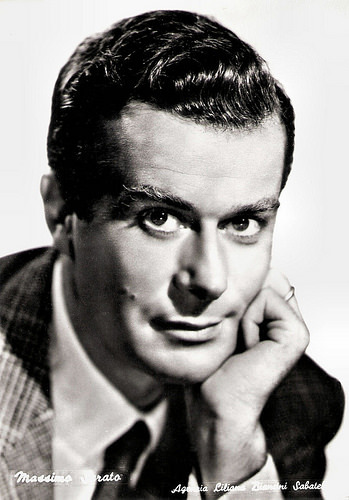
Italian postcard by Bromofoto, Milano, no. 1461. Photo: Agencia Liliana Biancini Sabatella.
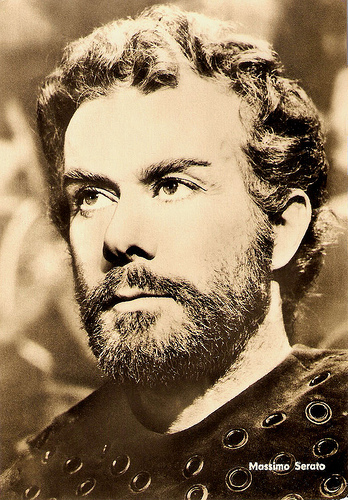
East-German postcard by VEB Progress Filmvertrieb, Berlin., no. 140/69. Retail price: 0,20 M. Photo: publicity still for El Cid (Anthony Mann, 1961).
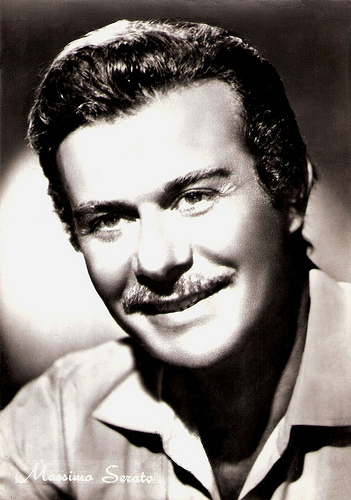
Italian postcard by Rotalfoto, Milano, no. 256. Photo: Manuelli, Tirrenia.
Versatile Talent
Massimo Serrato demonstrated a versatile talent during his long career. He starred as the hero or as the bad guy in the Peplum (sword and sandal epics) as well as in the Giallo (the typical Italian thriller), in Spaghetti westerns and in comedies. He also appeared in Fotoromanzi, the popular Italian photo booklets.
Serato eased gracefully into robust character roles in the late 1950s, like in the classic Il Grido/The Cry (Michelangelo Antonioni, 1957).
He appeared in international films like The Naked Maja (Henry Koster, Mario Russo, 1959) starring Ava Gardner , and the extravagant blockbusters El Cid (Anthony Mann, 1961) and 55 Days at Peking (Nicholas Ray, 1963) - both starring Charlton Heston.
In Italy he appeared in the Peplums David e Golia/David and Goliath (Ferdinando Baldi, Richard Pottier, 1960) with Orson Welles and Gli amori di Ercole/The Loves of Hercules (Carlo Ludovico Bragaglia, 1960) featuring husband and wife Mickey Hargitay and Jayne Mansfield .
Other interesting genre films in which he appeared were the SF-comedy La decima vittima/The Tenth Victim (Elio Petri, 1965) with Marcello Mastroianni , the Sexploitation Camille 2000 (Radley Metzger, 1969) as the father of Nino Castelnuovo, and the Spaghetti Western Anda muchacho, spara!/Dead Men Ride (Aldo Florio, 1971) starring Fabio Testi.
A highlight was the beautifully restrained psychological thriller Don't Look Now (Nicholas Roeg, 1973) with Julie Christie .
His final film part was in the James Hadley Chase adaptation L'avvoltoio può attendere/The Vulture Can Wait (Gian Pietro Calasso, 1991) starring Donald Pleasence.
Massimo Serato died in 1989, in Rome, Italy. He had a son, Cellino (1942 or 1943), from an affair with actress Anna Magnani, with whom he later appeared in Camicie rosse/Anita Garibaldi (Goffredo Alessandrini, 1951). Cellino, called Luca Magnani, contracted polio at an early age, and he would spent the rest of his life in a wheelchair.
Scene from Piccolo mondo antico (1941). Source: IPdT-Community (YouTube).
Trailer Il Grido (1957). Source: Danios 12345 (YouTube).
Long scene from Afrodite Dea Dell'Amore/Aphrodite, Goddess of Love (1958). Source: PEPLUMTV (YouTube).
Italian trailer for La Decima Vittima/The Tenth Victim (1965). Source: Neverlando 74 (YouTube).
Theatrical Trailer Don't Look Now (1973). Source: TheGePeU (YouTube).
Sources: Hal Erickson (AllMovie), Wikipedia, and .

Italian postcard by B.F.F. Edit., no. 4242-A. Photo: Bragaglia.

Italian postcard by B.F.F. Edit., no. 4293. Photo: Bragaglia.

Italian postcard by B.F.F. Edit., no. 4294. Photo: Bragaglia.

Italian postcard by B.F.F. Edit., no. 4587-A. Photo: E.N.I.C.

Italian postcard by A. Scarmaglia Ed. Roma (ASER). Photo: Ciolfi, Roma.
Tall, Blonde and Photogenic
Massimo Serato was born as Giuseppe Segato in 1916, in Oderzo, Italy. He abandoned his university studies, to attend the Centro Sperimentale, the Italian Film Academy in Rome.
He made his film debut in Inventiamo l'amore/Let’s Invent Love (Camillo Mastrocinque, 1938). His breakthrough was the historical drama Piccolo mondo antico/Little Old Fashioned World (Mario Soldati, 1941) with Alida Valli , about the Risorgimento, the unification of Italy.
From the early 1940s on, the tall, blonde and photogenic actor starred in films like L'uomo venuto dal mare/Man of the Sea (Belisario L. Randone, Roberto de Ribón, 1942), Giacomo l'idealista/Giacomo the Idealist (Alberto Lattuada, 1943), Le sorelle Materassi/The materassi Sisters (Ferdinando Maria Poggioli, 1944) and Quartieri alti/In High Places (Mario Soldati, 1943-1945).
After the war, he appeared in such Neorealist films like Il sole sorge ancora/Outcry (Aldo Vergano, 1946), Domenica D'Agosto/Sunday in August (Luciano Emmer, 1949) and the tragedy Febbre di vivere/Eager to Live (Claudio Gora, 1953) with Marina Berti .
He also appeared as the athletic hero in popular entertainment like La Traviata/The Lost One (Carmine Gallone, 1949) an adaptation of the opera of Giuseppe Verdi, the adventure Il Ladro di Venezia/The Thief of Venice (John Brahm, 1950) opposite Maria Montez in her last role, the historical drama Lucrece Borgia/Lucretia Borgia (Christian-Jacque, 1953) as the handsome lover of sex symbol Martine Carol , and L'Amante di Paride/The Loves of Three Queens (Marc Allégret, Edgar G. Ullmer, 1954) as one of the three loves of Hedy Lamarr .

Italian postcard for the 'fotoromanzo' Il padrone delle ferriere, starring Massimo Serato and Irene Galter, published in 'Grand Hotel' in 1960. It was based on Georges Ohnet's famous novel Le maitre des forges.

Italian postcard by Alterocca, Terni, no. 6617, 1941. Photo: Ferri / Sovrania Films.

Italian postcard by Bromostampa, Milano, no. 145.

Italian postcard by Bromofoto, Milano, no. 1461. Photo: Agencia Liliana Biancini Sabatella.

East-German postcard by VEB Progress Filmvertrieb, Berlin., no. 140/69. Retail price: 0,20 M. Photo: publicity still for El Cid (Anthony Mann, 1961).

Italian postcard by Rotalfoto, Milano, no. 256. Photo: Manuelli, Tirrenia.
Versatile Talent
Massimo Serrato demonstrated a versatile talent during his long career. He starred as the hero or as the bad guy in the Peplum (sword and sandal epics) as well as in the Giallo (the typical Italian thriller), in Spaghetti westerns and in comedies. He also appeared in Fotoromanzi, the popular Italian photo booklets.
Serato eased gracefully into robust character roles in the late 1950s, like in the classic Il Grido/The Cry (Michelangelo Antonioni, 1957).
He appeared in international films like The Naked Maja (Henry Koster, Mario Russo, 1959) starring Ava Gardner , and the extravagant blockbusters El Cid (Anthony Mann, 1961) and 55 Days at Peking (Nicholas Ray, 1963) - both starring Charlton Heston.
In Italy he appeared in the Peplums David e Golia/David and Goliath (Ferdinando Baldi, Richard Pottier, 1960) with Orson Welles and Gli amori di Ercole/The Loves of Hercules (Carlo Ludovico Bragaglia, 1960) featuring husband and wife Mickey Hargitay and Jayne Mansfield .
Other interesting genre films in which he appeared were the SF-comedy La decima vittima/The Tenth Victim (Elio Petri, 1965) with Marcello Mastroianni , the Sexploitation Camille 2000 (Radley Metzger, 1969) as the father of Nino Castelnuovo, and the Spaghetti Western Anda muchacho, spara!/Dead Men Ride (Aldo Florio, 1971) starring Fabio Testi.
A highlight was the beautifully restrained psychological thriller Don't Look Now (Nicholas Roeg, 1973) with Julie Christie .
His final film part was in the James Hadley Chase adaptation L'avvoltoio può attendere/The Vulture Can Wait (Gian Pietro Calasso, 1991) starring Donald Pleasence.
Massimo Serato died in 1989, in Rome, Italy. He had a son, Cellino (1942 or 1943), from an affair with actress Anna Magnani, with whom he later appeared in Camicie rosse/Anita Garibaldi (Goffredo Alessandrini, 1951). Cellino, called Luca Magnani, contracted polio at an early age, and he would spent the rest of his life in a wheelchair.
Scene from Piccolo mondo antico (1941). Source: IPdT-Community (YouTube).
Trailer Il Grido (1957). Source: Danios 12345 (YouTube).
Long scene from Afrodite Dea Dell'Amore/Aphrodite, Goddess of Love (1958). Source: PEPLUMTV (YouTube).
Italian trailer for La Decima Vittima/The Tenth Victim (1965). Source: Neverlando 74 (YouTube).
Theatrical Trailer Don't Look Now (1973). Source: TheGePeU (YouTube).
Sources: Hal Erickson (AllMovie), Wikipedia, and .
Published on June 29, 2016 22:00
June 28, 2016
Madame Tallien (1916)
Today a film special on one of the highlights of Cinema Ritrovata 2016, Madame Tallien/Madame Guillotine (Mario Caserini, Enrico Guazzoni, 1916), featuring diva Lyda Borelli. This Italian historical drama, set during the French revolution is part of the section ITALIA 1916: WOMEN AND WAR.
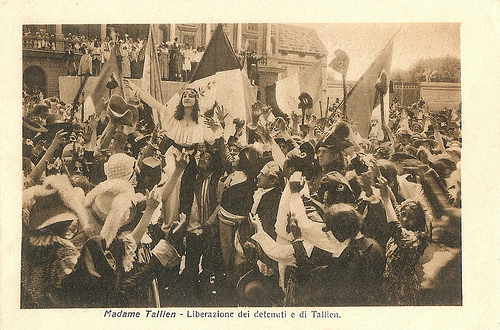
Italian postcard by IPA CT Duplex / Uff. Rev. St. Terni, no. 3271. Photo: Film Cines. Publicity still for Madame Tallien (Mario Caserini, Enrico Guazzoni, 1916), starring Lyda Borelli as Teresia Cabarus/Madame Tallien and Amleto Novelli as Tallien. Caption: The release of the prisoners and Tallien.
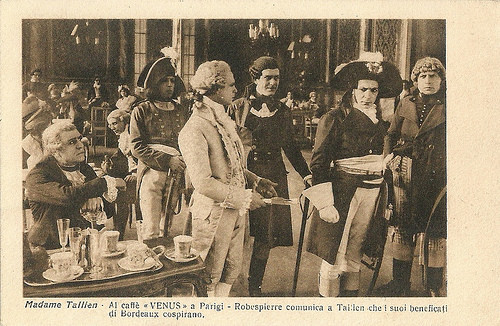
Italian postcard by IPA CT Duplex / Uff. Rev. St. Terni, no. 3272. Photo: Film Cines. Renzo Fabiani as Robespierre and Amleto Novelli as Tallien in Madame Tallien (Mario Caserini, Enrico Guazzoni, 1916). Caption: In café Venus in Paris, Robespierre communicates to Tallien who is his benefited conspirer from Bordeaux.
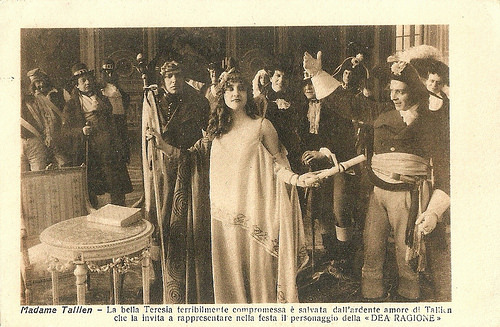
Italian postcard by IPA CT Duplex / Uff. Rev. St. Terni, no. 3274. Photo: Film Cines. Lyda Borelli as Teresia Cabarus/Madame Tallien and Amleto Novelli as Tallien in Madame Tallien (Mario Caserini, Enrico Guazzoni, 1916). Caption: The beautiful Teresia, terribly compromised, is saved by the burning love of Tallien who invited her to represent the personage of the 'Goddess of Reason' at the party.
The Goddess of Reason
Madame Tallien (Mario Caserini, Enrico Guazzoni, 1916) is an Italian production by Cines, based on the French play of the same name by Victorien Sardou.
Lyda Borelli stars as Marchioness Teresia Cabarus (in the play called Thérèse de Fontenay), who divorces her adulterous husband (Ettore Barcani) in order to marry young monarchist journalist Jean Guery (Ruggero Barni), but the French Revolution prevents this.
Teresia hides Guery in her house and when the French police searches her house, she pretends he is her husband, returned from the States. Teresia seduces Tallien ( Amleto Novelli ), member of the Comité au Salut Public, to calm the situation. She acts in public as The Goddess of Reason and becomes a success, enabling her to save many aristocratic head from the guillotine and conspiring with the royalists.
However when Teresia rejects Robespierre (Renzo Fabiani), she puts her life and that of Tallien at risk. The conspirators are arrested and Tallien cannot save Teresia. While the others, including her own husband and Guery, are brought the guillotine, Thérèse remains in prison and meets Tallien who promises to put an end to Robespierre if she becomes his. She agrees heartbroken.
In a heated session at the Convention Tallien attacks Robespierre, who is wounded, arrested and killed at the guillotine, as he had done with so many others before him. Guery is saved from beheading in the nick of time. Thérèse is liberated and knowing that Guery is safe she keeps her promise and becomes Madame Tallien. As a hero she is carried through the city.
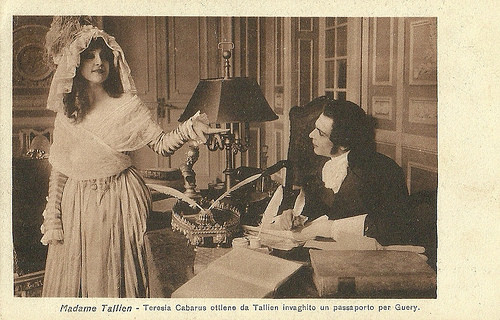
Italian postcard by IPA CT Duplex / Uff. Rev. St. Terni, no. 3275. Photo: Film Cines. Lyda Borelli as Teresia Cabarus/Madame Tallien, and Amleto Novelli as Tallien in Madame Tallien (Mario Caserini, Enrico Guazzoni, 1916). Caption: Teresia Cabarus gets a passport for Guery from the infatuated Tallien.
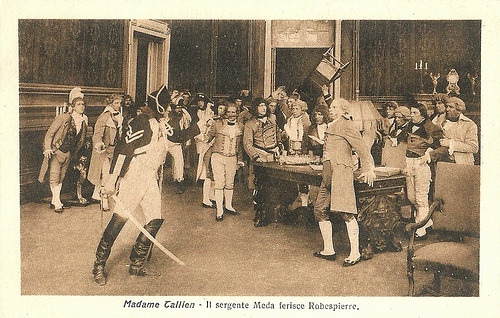
Italian postcard by IPA CT Duplex / Uff. Rev. St. Terni, no. 3276. Photo: Film Cines. Renzo Fabiani as Robespierre in Madame Tallien (Mario Caserini, Enrico Guazzoni, 1916). Caption: Sergeant Meda injures Robespierre.
Catastrophe
During production a catastrophe occurred, when a footboard collapsed because of the weight of all the extras on it and one extra was killed.
Madame Tallien premiered in Rome on 18 November 1916. It was praised in the Italian press for the realism in depicting scenes from the French Revolution, in particular the scene in the Convention in which Tallien knows to change the pro-Robespierre mood in anti-Robespierre-mood, the start of Robespierre's downfall.
There was also praise for the performances of Lyda Borelli and the male actors Amleto Novelli , Renzo Fabiani and Ruggero Barni.
In Great Britain, the film was originally released in 1917 as Robespierre In 1924 the film was rereleased as Madame Guillotine. The British journal The Bioscope again praised the performances and certain scenes such as the parade with Therese as Goddess of Reason and the scene in the convention.
One of our sources, film historian Vittorio Martinelli mentions in his study Il cinema muto italiano, 1916, II a negative ending with Guery and Tallien killed and Thérèse all alone. This is not the version you can watch on YouTube. I am curious which version we will see at Cinema Ritrovata in Bologna.
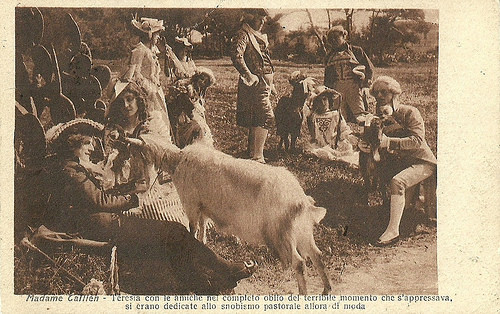
Italian postcard by IPA CT Duplex / Uff. Rev. St. Terni, no. 3277. Photo: Film Cines. Lyda Borelli as Teresia Cabarus/Madame Tallien, and Amleto Novelli as Tallien in Madame Tallien (Mario Caserini, Enrico Guazzoni, 1916). Caption: Teresia with friends in complete oblivion of the terrible moment that drew nigh, were dedicated to the pastoral snobbishness then fashionable.
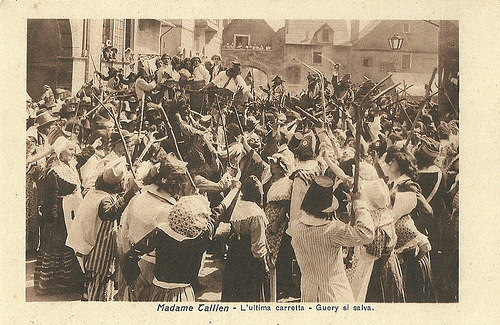
Italian postcard by IPA CT Duplex / Uff. Rev. St. Terni, no. 3279. Photo: Film Cines. Ruggero Barni as Jean Guery in the silent film Madame Tallien (Mario Caserini, Enrico Guazzoni, 1916). Caption: The last cart. Guery is saved.
Madame Tallien (1916). Source: JOEPINO LANANNA (YouTube).
Sources: Source: Vittorio Martinelli (Il cinema muto italiano, 1916, II - Italian), Wikipedia and IMDb.

Italian postcard by IPA CT Duplex / Uff. Rev. St. Terni, no. 3271. Photo: Film Cines. Publicity still for Madame Tallien (Mario Caserini, Enrico Guazzoni, 1916), starring Lyda Borelli as Teresia Cabarus/Madame Tallien and Amleto Novelli as Tallien. Caption: The release of the prisoners and Tallien.

Italian postcard by IPA CT Duplex / Uff. Rev. St. Terni, no. 3272. Photo: Film Cines. Renzo Fabiani as Robespierre and Amleto Novelli as Tallien in Madame Tallien (Mario Caserini, Enrico Guazzoni, 1916). Caption: In café Venus in Paris, Robespierre communicates to Tallien who is his benefited conspirer from Bordeaux.

Italian postcard by IPA CT Duplex / Uff. Rev. St. Terni, no. 3274. Photo: Film Cines. Lyda Borelli as Teresia Cabarus/Madame Tallien and Amleto Novelli as Tallien in Madame Tallien (Mario Caserini, Enrico Guazzoni, 1916). Caption: The beautiful Teresia, terribly compromised, is saved by the burning love of Tallien who invited her to represent the personage of the 'Goddess of Reason' at the party.
The Goddess of Reason
Madame Tallien (Mario Caserini, Enrico Guazzoni, 1916) is an Italian production by Cines, based on the French play of the same name by Victorien Sardou.
Lyda Borelli stars as Marchioness Teresia Cabarus (in the play called Thérèse de Fontenay), who divorces her adulterous husband (Ettore Barcani) in order to marry young monarchist journalist Jean Guery (Ruggero Barni), but the French Revolution prevents this.
Teresia hides Guery in her house and when the French police searches her house, she pretends he is her husband, returned from the States. Teresia seduces Tallien ( Amleto Novelli ), member of the Comité au Salut Public, to calm the situation. She acts in public as The Goddess of Reason and becomes a success, enabling her to save many aristocratic head from the guillotine and conspiring with the royalists.
However when Teresia rejects Robespierre (Renzo Fabiani), she puts her life and that of Tallien at risk. The conspirators are arrested and Tallien cannot save Teresia. While the others, including her own husband and Guery, are brought the guillotine, Thérèse remains in prison and meets Tallien who promises to put an end to Robespierre if she becomes his. She agrees heartbroken.
In a heated session at the Convention Tallien attacks Robespierre, who is wounded, arrested and killed at the guillotine, as he had done with so many others before him. Guery is saved from beheading in the nick of time. Thérèse is liberated and knowing that Guery is safe she keeps her promise and becomes Madame Tallien. As a hero she is carried through the city.

Italian postcard by IPA CT Duplex / Uff. Rev. St. Terni, no. 3275. Photo: Film Cines. Lyda Borelli as Teresia Cabarus/Madame Tallien, and Amleto Novelli as Tallien in Madame Tallien (Mario Caserini, Enrico Guazzoni, 1916). Caption: Teresia Cabarus gets a passport for Guery from the infatuated Tallien.

Italian postcard by IPA CT Duplex / Uff. Rev. St. Terni, no. 3276. Photo: Film Cines. Renzo Fabiani as Robespierre in Madame Tallien (Mario Caserini, Enrico Guazzoni, 1916). Caption: Sergeant Meda injures Robespierre.
Catastrophe
During production a catastrophe occurred, when a footboard collapsed because of the weight of all the extras on it and one extra was killed.
Madame Tallien premiered in Rome on 18 November 1916. It was praised in the Italian press for the realism in depicting scenes from the French Revolution, in particular the scene in the Convention in which Tallien knows to change the pro-Robespierre mood in anti-Robespierre-mood, the start of Robespierre's downfall.
There was also praise for the performances of Lyda Borelli and the male actors Amleto Novelli , Renzo Fabiani and Ruggero Barni.
In Great Britain, the film was originally released in 1917 as Robespierre In 1924 the film was rereleased as Madame Guillotine. The British journal The Bioscope again praised the performances and certain scenes such as the parade with Therese as Goddess of Reason and the scene in the convention.
One of our sources, film historian Vittorio Martinelli mentions in his study Il cinema muto italiano, 1916, II a negative ending with Guery and Tallien killed and Thérèse all alone. This is not the version you can watch on YouTube. I am curious which version we will see at Cinema Ritrovata in Bologna.

Italian postcard by IPA CT Duplex / Uff. Rev. St. Terni, no. 3277. Photo: Film Cines. Lyda Borelli as Teresia Cabarus/Madame Tallien, and Amleto Novelli as Tallien in Madame Tallien (Mario Caserini, Enrico Guazzoni, 1916). Caption: Teresia with friends in complete oblivion of the terrible moment that drew nigh, were dedicated to the pastoral snobbishness then fashionable.

Italian postcard by IPA CT Duplex / Uff. Rev. St. Terni, no. 3279. Photo: Film Cines. Ruggero Barni as Jean Guery in the silent film Madame Tallien (Mario Caserini, Enrico Guazzoni, 1916). Caption: The last cart. Guery is saved.
Madame Tallien (1916). Source: JOEPINO LANANNA (YouTube).
Sources: Source: Vittorio Martinelli (Il cinema muto italiano, 1916, II - Italian), Wikipedia and IMDb.
Published on June 28, 2016 22:00
June 27, 2016
Serge Reggiani
One of the programme sections at
Cinema Ritrovata 2016
is JACQUES BECKER – THE VERY IDEA OF FREEDOM. Becker is the director of such classics as Casque d'or (1952), starring Simone Signoret and Italian-born French singer and actor Serge Reggiani (1922-2004). After his breakthrough in Marcel Carné’s Les portes de la nuit/The Doors of the Night (1946), Reggiani went on to perform in 80 films including Le Doulos (1962), and Il Gattopardo/The Leopard (1963). In the 1960s he began a second career as a singer of chansons.
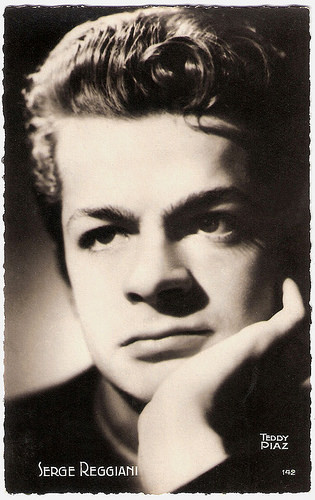
French postcard by Editions O.P., Paris, no. 142. Photo: Teddy Piaz.
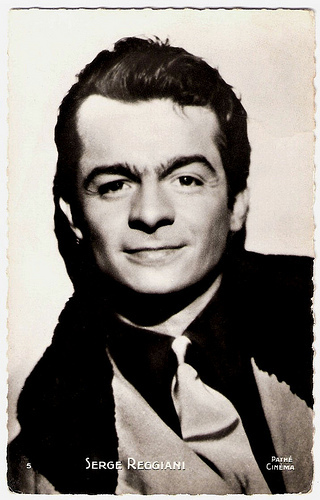
French postcard by Editions P.I., Paris, no. 5, presented by Biscuits Chocolats Victoria, Bruxelles. Photo: Pathé Cinema.
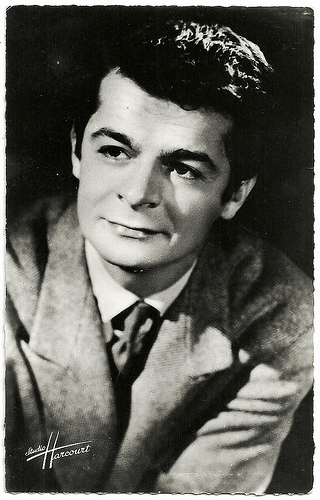
French postcard by Editions du Globe, Paris. Photo: Studio Harcourt.
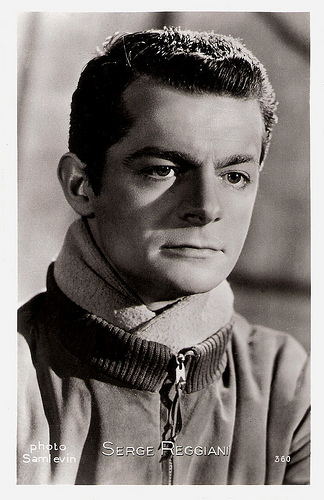
French postcard by Editions P.I., Paris, no. 360. Photo: Sam Lévin.
Revelation
Sergio Reggiani was born in Reggio Emilia, a town in northern Italy, in 1922. His father, a highly visible anti-fascist, fled his Mussolini-dictated homeland due to his fervent political activities and to protect his family. Serge moved to France with his parents at the age of eight. He learned to speak fluent French and developed an interest in athletics, particularly boxing, but went an entirely different route altogether by following in his father's footsteps as a hair stylist.
In 1937, Reggiani's career path changed yet again when he was accepted into the Conservatoire des Arts Cinematographiques. After graduation, he landed a few minor roles in both films and theatre and enrolled at the prestigious Conservatoire National d'Art Dramatique in 1939 wherein he won numerous acting awards.
He was discovered by Jean Cocteau and appeared in a wartime production of Les Parents terribles/The Terrible Parents. In the cinema he made a remarkable debut in Voyageur De La Toussaint/Traveller of The Toussaint (Louis Daquin, 1943) with Jean Desailly. His next film was Le carrefour des enfants perdus/Children of Chaos (Léo Joannon, 1944).
DbDumonteil writes at IMDb : “The movie was another Serge Reggiani's tour de force after his brilliant debut in Daquin's Voyageur De La Toussaint. Even if Feuillade's Wunderkind René Dary is the star of the film - and he is quite effective as a demobilised officer (and an ex-boarder of Belle Ile) -, Reggiani steals every scene he is in predating the rebels without a cause who would appear in the American cinema of the fifties. His not-so-good-looking face, his sunken features in spite of his young age, his rebellious swagger made him the revelation of those dark years, because he looked the part so much.”
During the filming of Le carrefour des enfants perdus, he met and subsequently married actress Janine Darcey. They had two children: Stephan (1946) and Carine (1951). During World War II, he left Paris to join the French resistance. Though he earned a reputation for himself in the Paris theatre world, Reggiani was more interested in film-making and would thereafter focus his attention toward the big screen.
He starred in the classic Les portes de la nuit/The Gates of the Night (Marcel Carné, 1946). After obtaining French citizenship in 1948, he went on to secure a name for himself in the French cinema with roles in Manon (Henri-Georges Clouzot, 1949) with Cécile Aubry , Les amants de Vérone/The Lovers of Verona (André Cayatte, 1949) opposite Anouk Aimée , La ronde (Max Ophüls, 1950) and Casque d'or (Jacques Becker, 1952) featuring Simone Signoret, who became a close friend.
Following his divorce from Janine Darcey, he married actress Annie Noël in 1958 and they had three children: Celia (1958), Simon (1961) and Maria (1963).
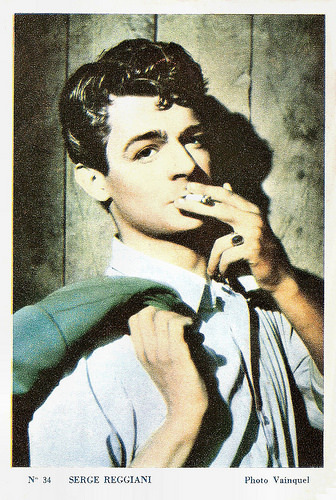
Belgian collectors card by Merbotex, Bruxelles / Kursaal, Bertrix, no. 34. Photo: Vainquel.
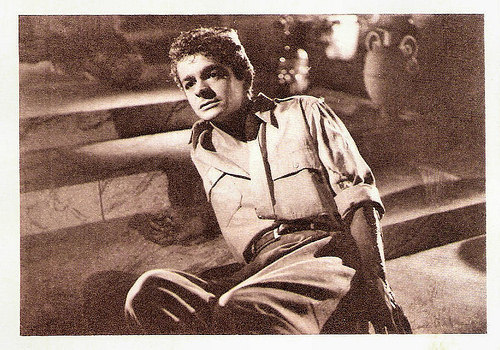
French collectors card. Photo: publicity still for Les amants de Vérone/The Lovers of Verona (André Cayatte, 1949).
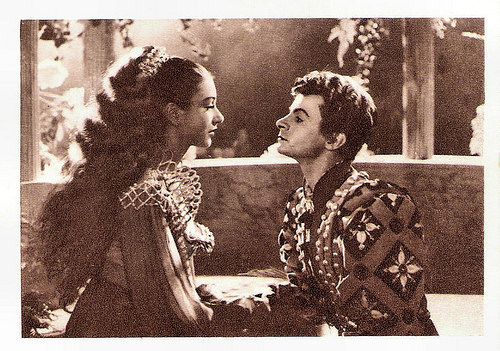
French collectors card. Photo: publicity still for Les amants de Vérone/The Lovers of Verona (André Cayatte, 1949) with Anouk Aimée .
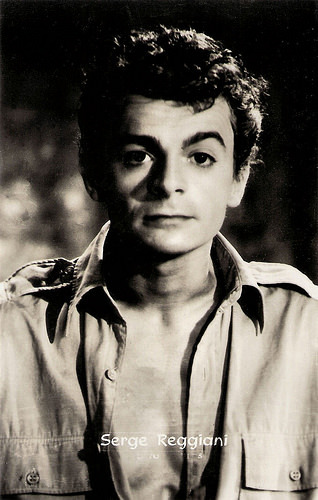
French postcard.
True Vocation
After a promising start Serge Reggiani had never quite reached the peak with his acting career. In 1959, he seemed to have found his true vocation when he introduced a distinctive singing talent on the radio. That same year he also had a triumph in the theatre with his performance in Jean-Paul Sartre’s play Les Séquestrés d'Altona.
In the cinema he was busy in two more classics: the thriller Le doulos (Jean-Pierre Melville, 1962) staring Jean-Paul Belmondo , and the historical epic Il gattopardo/The Leopard (Luchino Visconti, 1963) starring Burt Lancaster and Alain Delon .
But in 1965 he finally could launch a musical career with the help of Simone Signoret and her husband Yves Montand and later with great assistance of the French diva Barbara. At the age of 43, he released his award-winning debut album and it proved to be such a major hit with both the French public and the critics that singing became a prime career.
As an actor he knew how to ‘perform’ a song, provoking sometimes laughter but mainly emotion. The deep voiced Reggiani became one of the most acclaimed performers of French chanson and although he was in his 40s, his bad-boy rugged image made him popular with both young and older listeners. A second album produced in 1967, plus a left-wing concert with Jacques Brel , clenched his popularity with the younger politically left generation of the late 1960s.
He began to extend himself internationally while continuing a healthy album output. Reggiani’s best known songs include Les loups sont entrés dans Paris (The Wolves Have Entered Paris) and Sarah (La femme qui est dans mon lit) (The Woman Who Is In My Bed), the latter written by Georges Moustaki. However, one of his regular songwriters throughout his career was Boris Vian (Le Déserteur, Arthur où t'as mis le corps, La Java des bombes atomiques). His new young fans identified with his left-wing ideals and anti militarism, most notably during the 1968 student revolts in France.
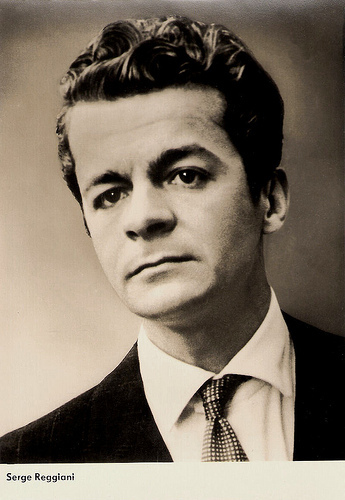
East-German postcard by VEB Progress Filmvertrieb, Berlin, no. 1457.
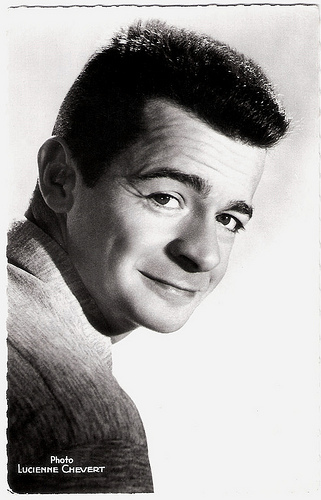
French postcard by Editions du Globe, Paris, no. 465. Photo: Lucienne Chevert.
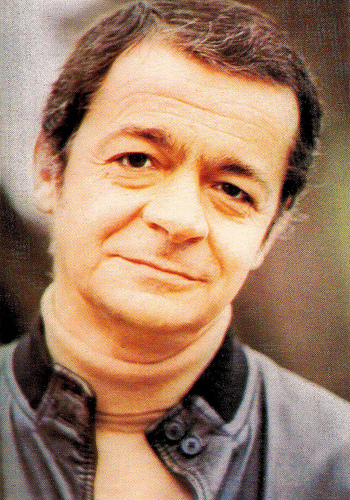
French card, no. 10.
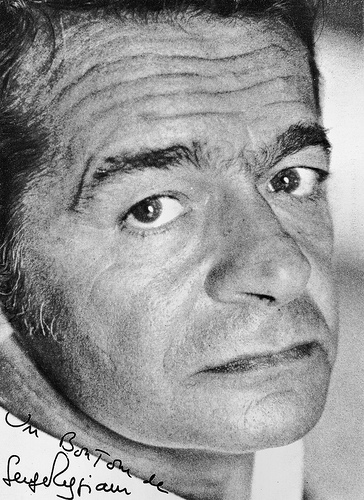
French postcard by La Roue Tourne, Paris.
Depression and Alcoholism
During the 1970s Serge Reggiani played supporting parts in several interesting films, such as Touche pas à la femme blanche/Don’t Touch the White Woman (Marco Ferreri, 1974) featuring Catherine Deneuve , Vincent, François, Paul... et les autres/ Vincent, François, Paul... and the Others (Claude Sautet, 1974) with Yves Montand , and La terrazza/The Terrace (Ettore Scola, 1980) with Vittorio Gassman .
With age Reggiani became more and more acclaimed as one of the best interpreters of the French chanson also bringing the poetry of Rimbaud, Apollinaire and Prévert closer to his audience. Children Stephan and Carine actively developed their own singing careers and Reggiani performed on the concert stage with them in encouragement but with lacklustre results. Son Stephan, completely overshadowed by his father, took this extremely hard and in 1980 committed suicide at the family home in Mougins. He was only 33.
Devastated, Reggiani withdrew from the music scene for a while to recover from his grief. For many years, he struggled with depression and alcoholism. Divorced from his second wife in 1973, he met actress Noëlle Adam in the 1980s and they lived in partnership for over 20 years, she becoming a lasting source of strength for him in dealing with his personal tragedies.
In 1985 the French government paid tribute to Reggiani's singing and acting careers with the prestigious Legion of Honor award. His later years would be more or less spent in seclusion, finding one last passion in painting. He displayed his works at his first exhibition in 1989. After performing in concert to mark the 25th anniversary of his singing career, Reggiani found the strength to return to the French music scene. In 1995, at age 70+, he successfully recorded and was welcomed back to the concert stage with great applause.
Though his acting career had calmed down a great deal, he did star in De force avec d'autres/Forced To Be With Others (1993), a film written and directed by his son Simon Reggiani that also featured Noëlle Adam . In 1998 he appeared in his final feature film El pianist/The Pianist (Mario Gas, 1998).
Reggiani and Adam married in 2003. His last concert was held as late as in the year of his death, in spring of 2004. Serge Reggiani died at his Paris home of a heart attack at the age of 82.
All of Reggiani's children inherited their father's artistic talents and have worked in the field of entertainment. Son Simon is a well-known director/writer/actor; daughters Carine and Celia work in music (the former is a singer-turned songwriter, the latter a musician); daughter Maria is a film editor; and grandson Nicolas has followed in the family footsteps as well. He launched a career as a singer performing songs covered by his late father, Stephan, Serge's oldest son.
Scene from Casque d'or (Jacques Becker, 1952) featuring Simone Signoret. Source: Little Ice Age (YouTube).
Trailer for Il Gattopardo (1963). Source: Blondinka Inoz (YouTube).
Serge Reggiani sings Sarah. Source: José Ramón San Juan (YouTube).
Serge Reggiani sings Madame (1969). Source: diverseclipuri (YouTube).
Sources: (IMDb), Wikipedia, and .

French postcard by Editions O.P., Paris, no. 142. Photo: Teddy Piaz.

French postcard by Editions P.I., Paris, no. 5, presented by Biscuits Chocolats Victoria, Bruxelles. Photo: Pathé Cinema.

French postcard by Editions du Globe, Paris. Photo: Studio Harcourt.

French postcard by Editions P.I., Paris, no. 360. Photo: Sam Lévin.
Revelation
Sergio Reggiani was born in Reggio Emilia, a town in northern Italy, in 1922. His father, a highly visible anti-fascist, fled his Mussolini-dictated homeland due to his fervent political activities and to protect his family. Serge moved to France with his parents at the age of eight. He learned to speak fluent French and developed an interest in athletics, particularly boxing, but went an entirely different route altogether by following in his father's footsteps as a hair stylist.
In 1937, Reggiani's career path changed yet again when he was accepted into the Conservatoire des Arts Cinematographiques. After graduation, he landed a few minor roles in both films and theatre and enrolled at the prestigious Conservatoire National d'Art Dramatique in 1939 wherein he won numerous acting awards.
He was discovered by Jean Cocteau and appeared in a wartime production of Les Parents terribles/The Terrible Parents. In the cinema he made a remarkable debut in Voyageur De La Toussaint/Traveller of The Toussaint (Louis Daquin, 1943) with Jean Desailly. His next film was Le carrefour des enfants perdus/Children of Chaos (Léo Joannon, 1944).
DbDumonteil writes at IMDb : “The movie was another Serge Reggiani's tour de force after his brilliant debut in Daquin's Voyageur De La Toussaint. Even if Feuillade's Wunderkind René Dary is the star of the film - and he is quite effective as a demobilised officer (and an ex-boarder of Belle Ile) -, Reggiani steals every scene he is in predating the rebels without a cause who would appear in the American cinema of the fifties. His not-so-good-looking face, his sunken features in spite of his young age, his rebellious swagger made him the revelation of those dark years, because he looked the part so much.”
During the filming of Le carrefour des enfants perdus, he met and subsequently married actress Janine Darcey. They had two children: Stephan (1946) and Carine (1951). During World War II, he left Paris to join the French resistance. Though he earned a reputation for himself in the Paris theatre world, Reggiani was more interested in film-making and would thereafter focus his attention toward the big screen.
He starred in the classic Les portes de la nuit/The Gates of the Night (Marcel Carné, 1946). After obtaining French citizenship in 1948, he went on to secure a name for himself in the French cinema with roles in Manon (Henri-Georges Clouzot, 1949) with Cécile Aubry , Les amants de Vérone/The Lovers of Verona (André Cayatte, 1949) opposite Anouk Aimée , La ronde (Max Ophüls, 1950) and Casque d'or (Jacques Becker, 1952) featuring Simone Signoret, who became a close friend.
Following his divorce from Janine Darcey, he married actress Annie Noël in 1958 and they had three children: Celia (1958), Simon (1961) and Maria (1963).

Belgian collectors card by Merbotex, Bruxelles / Kursaal, Bertrix, no. 34. Photo: Vainquel.

French collectors card. Photo: publicity still for Les amants de Vérone/The Lovers of Verona (André Cayatte, 1949).

French collectors card. Photo: publicity still for Les amants de Vérone/The Lovers of Verona (André Cayatte, 1949) with Anouk Aimée .

French postcard.
True Vocation
After a promising start Serge Reggiani had never quite reached the peak with his acting career. In 1959, he seemed to have found his true vocation when he introduced a distinctive singing talent on the radio. That same year he also had a triumph in the theatre with his performance in Jean-Paul Sartre’s play Les Séquestrés d'Altona.
In the cinema he was busy in two more classics: the thriller Le doulos (Jean-Pierre Melville, 1962) staring Jean-Paul Belmondo , and the historical epic Il gattopardo/The Leopard (Luchino Visconti, 1963) starring Burt Lancaster and Alain Delon .
But in 1965 he finally could launch a musical career with the help of Simone Signoret and her husband Yves Montand and later with great assistance of the French diva Barbara. At the age of 43, he released his award-winning debut album and it proved to be such a major hit with both the French public and the critics that singing became a prime career.
As an actor he knew how to ‘perform’ a song, provoking sometimes laughter but mainly emotion. The deep voiced Reggiani became one of the most acclaimed performers of French chanson and although he was in his 40s, his bad-boy rugged image made him popular with both young and older listeners. A second album produced in 1967, plus a left-wing concert with Jacques Brel , clenched his popularity with the younger politically left generation of the late 1960s.
He began to extend himself internationally while continuing a healthy album output. Reggiani’s best known songs include Les loups sont entrés dans Paris (The Wolves Have Entered Paris) and Sarah (La femme qui est dans mon lit) (The Woman Who Is In My Bed), the latter written by Georges Moustaki. However, one of his regular songwriters throughout his career was Boris Vian (Le Déserteur, Arthur où t'as mis le corps, La Java des bombes atomiques). His new young fans identified with his left-wing ideals and anti militarism, most notably during the 1968 student revolts in France.

East-German postcard by VEB Progress Filmvertrieb, Berlin, no. 1457.

French postcard by Editions du Globe, Paris, no. 465. Photo: Lucienne Chevert.

French card, no. 10.

French postcard by La Roue Tourne, Paris.
Depression and Alcoholism
During the 1970s Serge Reggiani played supporting parts in several interesting films, such as Touche pas à la femme blanche/Don’t Touch the White Woman (Marco Ferreri, 1974) featuring Catherine Deneuve , Vincent, François, Paul... et les autres/ Vincent, François, Paul... and the Others (Claude Sautet, 1974) with Yves Montand , and La terrazza/The Terrace (Ettore Scola, 1980) with Vittorio Gassman .
With age Reggiani became more and more acclaimed as one of the best interpreters of the French chanson also bringing the poetry of Rimbaud, Apollinaire and Prévert closer to his audience. Children Stephan and Carine actively developed their own singing careers and Reggiani performed on the concert stage with them in encouragement but with lacklustre results. Son Stephan, completely overshadowed by his father, took this extremely hard and in 1980 committed suicide at the family home in Mougins. He was only 33.
Devastated, Reggiani withdrew from the music scene for a while to recover from his grief. For many years, he struggled with depression and alcoholism. Divorced from his second wife in 1973, he met actress Noëlle Adam in the 1980s and they lived in partnership for over 20 years, she becoming a lasting source of strength for him in dealing with his personal tragedies.
In 1985 the French government paid tribute to Reggiani's singing and acting careers with the prestigious Legion of Honor award. His later years would be more or less spent in seclusion, finding one last passion in painting. He displayed his works at his first exhibition in 1989. After performing in concert to mark the 25th anniversary of his singing career, Reggiani found the strength to return to the French music scene. In 1995, at age 70+, he successfully recorded and was welcomed back to the concert stage with great applause.
Though his acting career had calmed down a great deal, he did star in De force avec d'autres/Forced To Be With Others (1993), a film written and directed by his son Simon Reggiani that also featured Noëlle Adam . In 1998 he appeared in his final feature film El pianist/The Pianist (Mario Gas, 1998).
Reggiani and Adam married in 2003. His last concert was held as late as in the year of his death, in spring of 2004. Serge Reggiani died at his Paris home of a heart attack at the age of 82.
All of Reggiani's children inherited their father's artistic talents and have worked in the field of entertainment. Son Simon is a well-known director/writer/actor; daughters Carine and Celia work in music (the former is a singer-turned songwriter, the latter a musician); daughter Maria is a film editor; and grandson Nicolas has followed in the family footsteps as well. He launched a career as a singer performing songs covered by his late father, Stephan, Serge's oldest son.
Scene from Casque d'or (Jacques Becker, 1952) featuring Simone Signoret. Source: Little Ice Age (YouTube).
Trailer for Il Gattopardo (1963). Source: Blondinka Inoz (YouTube).
Serge Reggiani sings Sarah. Source: José Ramón San Juan (YouTube).
Serge Reggiani sings Madame (1969). Source: diverseclipuri (YouTube).
Sources: (IMDb), Wikipedia, and .
Published on June 27, 2016 22:00
June 26, 2016
Diana Karenne
We're at the 30th edition of Cinema Ritrovata. Till 2 July we'll stay in Bologna, Italy, to blog about the stars of the festival. In the programme section ITALIA 1916: WOMEN AND WAR a fragment of Oltre la Vita, oltre la morte (Ernesto Maria Pasquali, 1916) will be presented. This fragment was recently preserved at the Museo Nazionale del Cinema in Torino (Turin). This is interesting while there are just a few still existing films with Diana Karenne (1888-1940), one of the divas of the silent Italian cinema. Between 1916 and 1920, Karenne fascinated European audiences with her eccentric dresses and make-up, and with her primadonna behaviour.
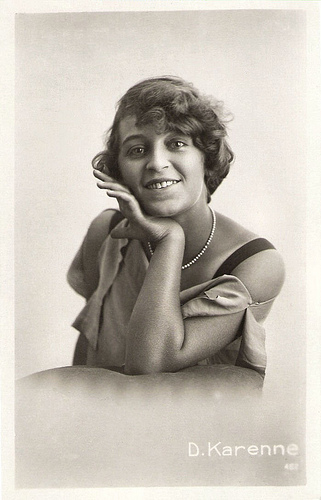
Italian postcard by Photo Vettori, Bologna.
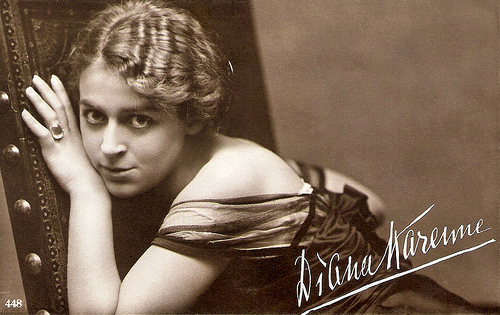
Italian postcard by Ed. A. Traldi, Milano, no. 448.
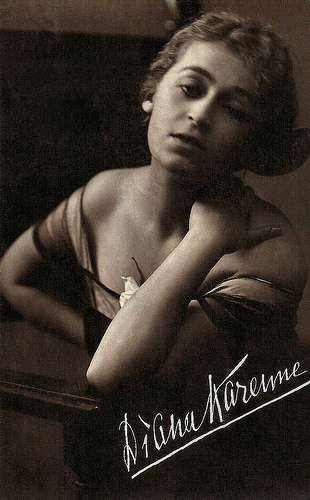
Italian postcard by Fotocelere, Torino.
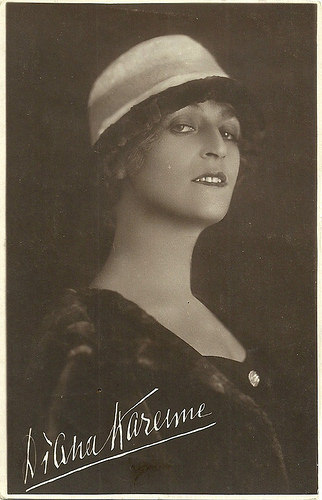
Italian postcard by Fotocelere, Torino.
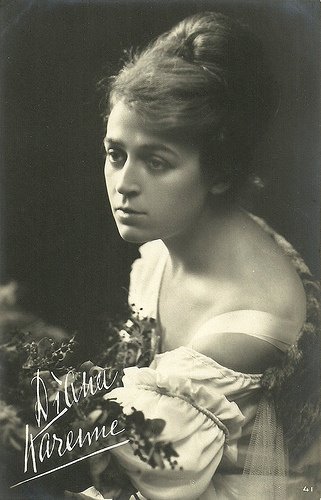
Italian postcard by Fotocelere, Torino, no. 41.
Gypsy Passion
Diana Karenne was born as Leucadia Konstantia in 1888 in Kiev in the Russian Empire (now Ukraine). Some sources mention the former Prussian cities Danzig (now Gdansk, Poland) or Stettin (now Szczeczin, Poland) as her birthplace.
Her brother was film producer Gregor Rabinovitch, who worked in the German film industry during the 1920s and early 1930s.
In 1915 she landed in Turin in Italy where she got acquainted with producer Ernesto Maria Pasquali.
He launched her in Passione tzigana/Gypsy Passion (Umberto Paradisi, 1916).
Immediately she became a star, and between 1916 and 1922 she played leads in many successful films.
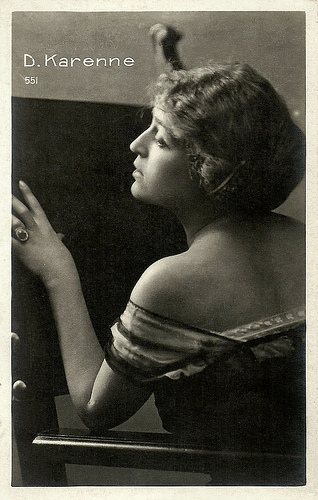
Italian postcard. Vettori, Bologna, no. 551.
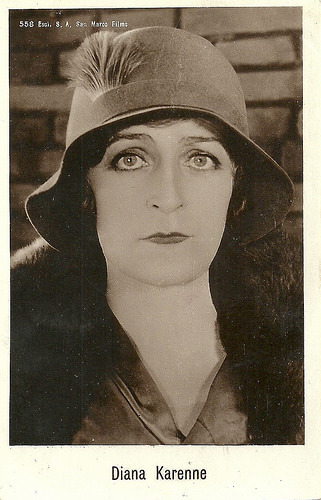
Italian postcard by Esci, S.A., no. 558 Photo: San Marco Films.
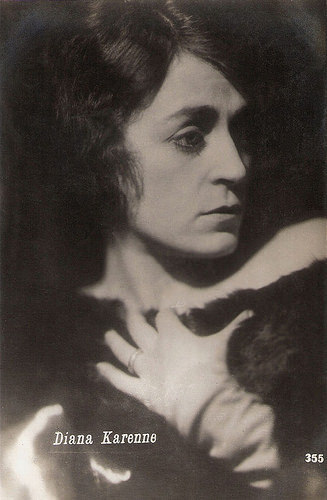
Italian postcard, no. 355.
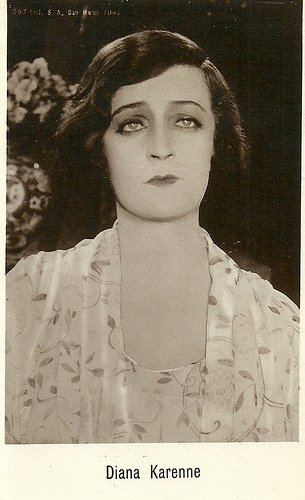
Italian postcard by G.B. Falci, Milano, no. 567. Photo: Distr. SA San Marco Films.
Maud, don't play with my passion
Quite soon, Diana Karenne managed to write and direct her own films, and she even designed her own film posters.
Il romanzo di Maud/Maud's Romance (1917) was the second film Karenne directed herself, after Lea (Diana Karenne, Salvatore Aversano, 1916). She also played the lead in both films.
Il romanzo di Maud, based on the French novel Les demi-vierges (1895) by Marcel Prévost, tells the tale of the free-spirited Maud de Vouvres. Maud's lover is an opportunistic and dubious gentleman, Giuliano di Suberceaux. When their relationship has an impasse, Maud sees new perspectives in Massimo, a provincial enamored with her.
Giuliano doesn't give up and forces her to see him in secret. When Maud en Massimo are married, Giuliano tells poor Massimo the truth, but Maud denies all and chases him away. When Giuliano menaces to kill himself, she coldly responds that she doesn't care.
When Massimo forces her to tell, Maud admits her former love but states Massimo is now her only love. Massimo, though, abandons her, unable to forgive her.
The film was heavily censored in Italy. After its first release, it always circulated as Les demi-vierges, in particular abroad.
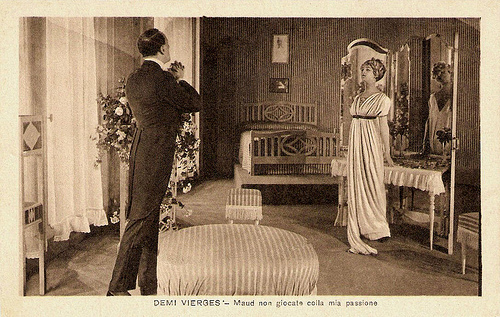
Italian postcard by Film Soc. An. Ambrosio, Torino. "Maud, don't play with my passion", her lover Giuliano implores her in Il romanzo di Maud (1917).
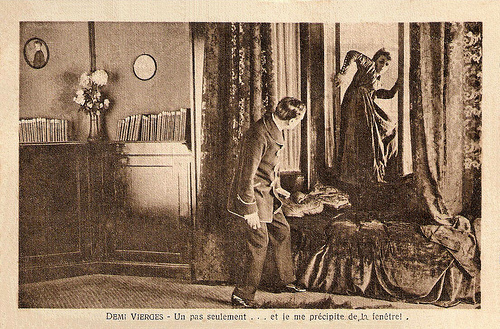
Italian postcard by Film Soc. An. Ambrosio, Torino. "One step further and I throw myself from the window", Maud (Diana Karenne) says in Il romanzo di Maud (1917).
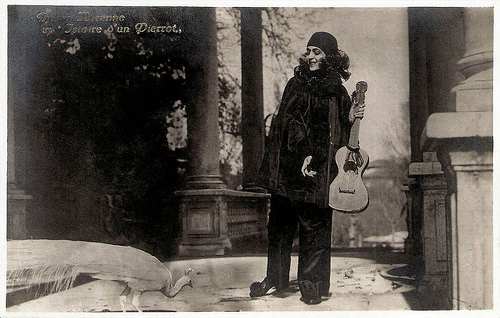
Italian postcard by G.B. Falci, Milano. Photo: still of Diana Karenne in Pierrot/Histoire d'un Pierrot (1917).
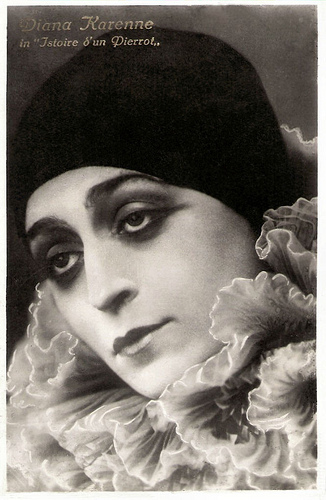
Italian postcard for Pierrot/Histoire d'un Pierrot (1917).
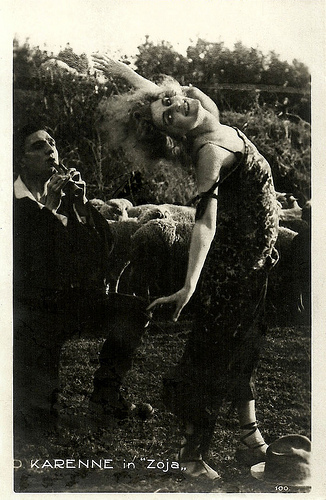
Italian postcard by Vettori, Bologna. Photo: Diana Karenne in the Italian silent film Zoya or Zoja (Giulio Antamoro, 1920), a Tiber Film production. The man left might be Mario Parpagnoli.
Pierrot
Diana Karenne also directed herself in Pierrot/Histoire d'un Pierrot (1917).
She also continued to play in films by other directors, such as Redenzione (Carmine Gallone, 1919), Zoya (Giulio Antamoro, 1920) with André Habay, Miss Dorothy (Giulio Antamoro, 1920) with Carmen Boni, and Smarrita (Giulio Antamoro, 1921).
Inspired by the first film superstar Asta Nielsen , Karenne played women who opposed society.
Between 1916 and 1920 Karenne fascinated audiences with her eccentric dresses and make-up, and her primadonna behaviour. Critics didn't accept her transgressive characters but the public flocked to see her films.
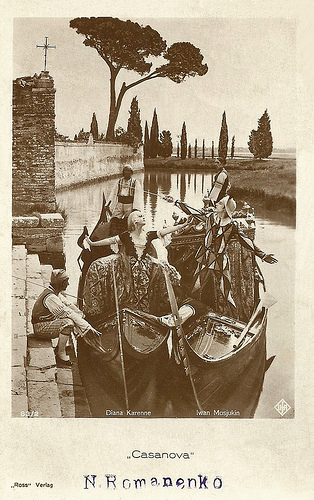
German postcard by Ross Verlag, no. 83/2. Photo: Ufa. Publicity still of Diana Karenne and Ivan Mozzhukhin in Casanova (Alexandre Volkoff, 1927). This scene was shot near the Venice cemetery Isola di San Michele.
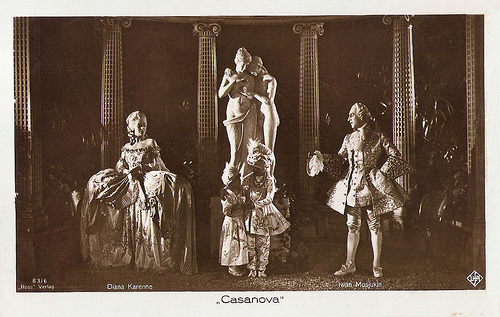
German postcard by Ross Verlag, no. 83/6. Photo: Ufa. Publicity still of Diana Karenne and Ivan Mozzhukhin in Casanova (Alexandre Volkoff, 1927).
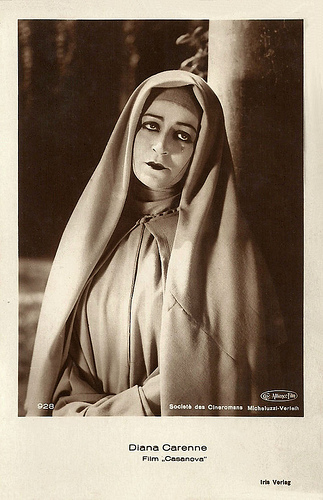
Austrian postcard by Iris Verlag, no. 928. Photo: Société des Cineromans / Micheluzzi-Verleih / Cine Alliance Film. Publicity still for Casanova (Alexandre Volkoff, 1927).
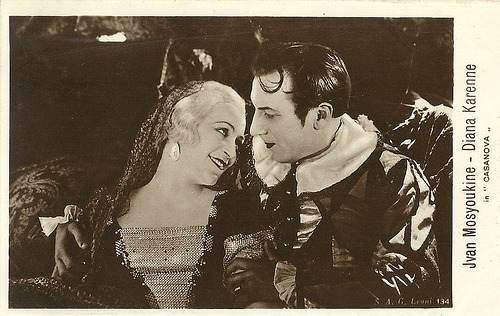
Italian postcard by S.A.G. Leoni, no. 134. Photo: publicity still of Diana Karenne and Ivan Mozzhukhin in Casanova (Alexandre Volkoff, 1927).
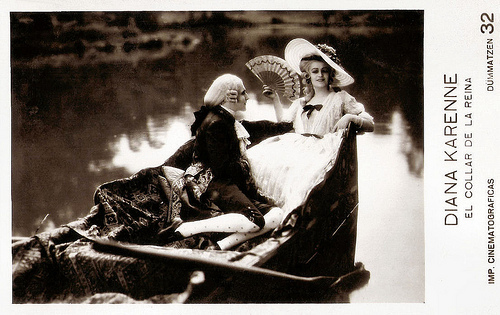
Spanish postcard by PD / Imp. Cinematorgaphicas Dümmatzen, no. 32. Photo: publicity still for Le collier de la Reine/The Queen's Necklace (Tony Lekain, Gaston Ravel, 1929).
Casanova's Major Lover
In 1921, when things went bad for the Italian film industry, Diana Karenne moved to Paris and later to Berlin.
In Germany she had major roles such as the title role in Marie Antoinette (Rudolf Meinert, 1922), and as one of Casanova's lovers in the visually splendid Casanova (Alexandre Volkoff, 1926) starring Ivan Mozzhukhin.
Other directors of her films were Robert Wiene (Das Spiel mit dem Feuer/Playing With Fire (1921)), Richard Oswald (Die Frau von vierzig Jahren/A Forty Years Old Woman (1925)), Yakov Protazananov (L'ombre de péché/The Shadow of Sin (1923)), and Gaston Ravel (Le collier de la reine/The Queen's Necklace (1929)).
When sound film arrived, Diana Karenne retired from the film business. She withdrew with her husband to the German city of Aachen, only reappearing once in a bit part in Manon Lescaut (Carmine Gallone, 1940), an Italian production derived from the work of Abbé Prévost, starring Alida Valli and Vittorio de Sica .
Karenne was also a painter, musician and poet. In July 1940 she was heavily injured by allied bombing of Aachen and she remained in coma for three months, never regaining consciousness. Diana Karenne died in October 1940.
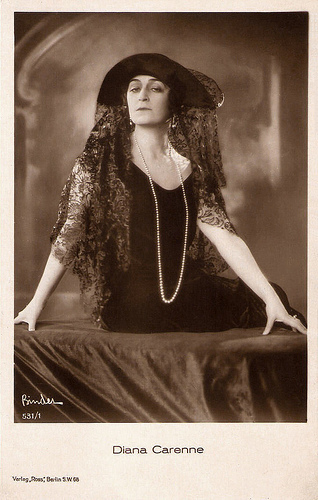
German Postcard by Ross Verlag, Berlin, no. 531/1, 1919-1924. Photo: Alex Binder.
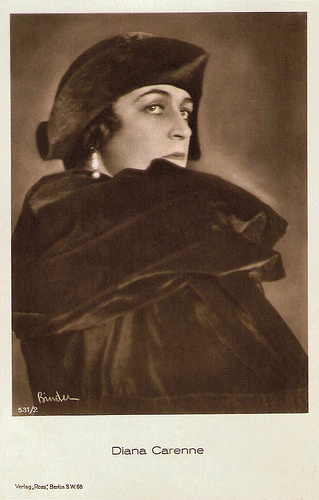
German Postcard by Ross Verlag, Berlin, no. 531/2, 1919-1924. Photo: Alex Binder.
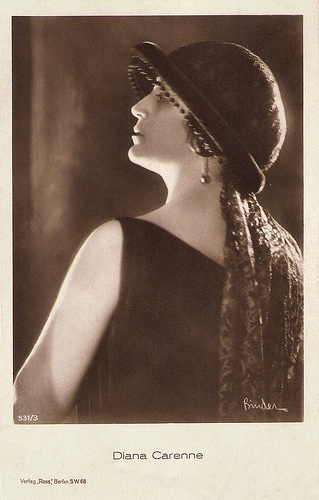
German Postcard by Ross Verlag, Berlin, no. 531/3, 1919-1924. Photo: Alex Binder.
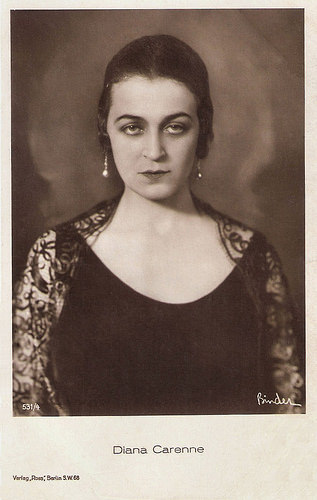
German postcard by Ross Verlag, Berlin, no. 531/4, 1919-1924. Photo: Alex Binder.
Sources: Marlène Pilaete (CinéArtistes.Com), Vittorio Martinelli, (Le dive del silenzio), Vittorio Martinelli (Il cinema muto italiano, 1917), Wikipedia (German), and

Italian postcard by Photo Vettori, Bologna.

Italian postcard by Ed. A. Traldi, Milano, no. 448.

Italian postcard by Fotocelere, Torino.

Italian postcard by Fotocelere, Torino.

Italian postcard by Fotocelere, Torino, no. 41.
Gypsy Passion
Diana Karenne was born as Leucadia Konstantia in 1888 in Kiev in the Russian Empire (now Ukraine). Some sources mention the former Prussian cities Danzig (now Gdansk, Poland) or Stettin (now Szczeczin, Poland) as her birthplace.
Her brother was film producer Gregor Rabinovitch, who worked in the German film industry during the 1920s and early 1930s.
In 1915 she landed in Turin in Italy where she got acquainted with producer Ernesto Maria Pasquali.
He launched her in Passione tzigana/Gypsy Passion (Umberto Paradisi, 1916).
Immediately she became a star, and between 1916 and 1922 she played leads in many successful films.

Italian postcard. Vettori, Bologna, no. 551.

Italian postcard by Esci, S.A., no. 558 Photo: San Marco Films.

Italian postcard, no. 355.

Italian postcard by G.B. Falci, Milano, no. 567. Photo: Distr. SA San Marco Films.
Maud, don't play with my passion
Quite soon, Diana Karenne managed to write and direct her own films, and she even designed her own film posters.
Il romanzo di Maud/Maud's Romance (1917) was the second film Karenne directed herself, after Lea (Diana Karenne, Salvatore Aversano, 1916). She also played the lead in both films.
Il romanzo di Maud, based on the French novel Les demi-vierges (1895) by Marcel Prévost, tells the tale of the free-spirited Maud de Vouvres. Maud's lover is an opportunistic and dubious gentleman, Giuliano di Suberceaux. When their relationship has an impasse, Maud sees new perspectives in Massimo, a provincial enamored with her.
Giuliano doesn't give up and forces her to see him in secret. When Maud en Massimo are married, Giuliano tells poor Massimo the truth, but Maud denies all and chases him away. When Giuliano menaces to kill himself, she coldly responds that she doesn't care.
When Massimo forces her to tell, Maud admits her former love but states Massimo is now her only love. Massimo, though, abandons her, unable to forgive her.
The film was heavily censored in Italy. After its first release, it always circulated as Les demi-vierges, in particular abroad.

Italian postcard by Film Soc. An. Ambrosio, Torino. "Maud, don't play with my passion", her lover Giuliano implores her in Il romanzo di Maud (1917).

Italian postcard by Film Soc. An. Ambrosio, Torino. "One step further and I throw myself from the window", Maud (Diana Karenne) says in Il romanzo di Maud (1917).

Italian postcard by G.B. Falci, Milano. Photo: still of Diana Karenne in Pierrot/Histoire d'un Pierrot (1917).

Italian postcard for Pierrot/Histoire d'un Pierrot (1917).

Italian postcard by Vettori, Bologna. Photo: Diana Karenne in the Italian silent film Zoya or Zoja (Giulio Antamoro, 1920), a Tiber Film production. The man left might be Mario Parpagnoli.
Pierrot
Diana Karenne also directed herself in Pierrot/Histoire d'un Pierrot (1917).
She also continued to play in films by other directors, such as Redenzione (Carmine Gallone, 1919), Zoya (Giulio Antamoro, 1920) with André Habay, Miss Dorothy (Giulio Antamoro, 1920) with Carmen Boni, and Smarrita (Giulio Antamoro, 1921).
Inspired by the first film superstar Asta Nielsen , Karenne played women who opposed society.
Between 1916 and 1920 Karenne fascinated audiences with her eccentric dresses and make-up, and her primadonna behaviour. Critics didn't accept her transgressive characters but the public flocked to see her films.

German postcard by Ross Verlag, no. 83/2. Photo: Ufa. Publicity still of Diana Karenne and Ivan Mozzhukhin in Casanova (Alexandre Volkoff, 1927). This scene was shot near the Venice cemetery Isola di San Michele.

German postcard by Ross Verlag, no. 83/6. Photo: Ufa. Publicity still of Diana Karenne and Ivan Mozzhukhin in Casanova (Alexandre Volkoff, 1927).

Austrian postcard by Iris Verlag, no. 928. Photo: Société des Cineromans / Micheluzzi-Verleih / Cine Alliance Film. Publicity still for Casanova (Alexandre Volkoff, 1927).

Italian postcard by S.A.G. Leoni, no. 134. Photo: publicity still of Diana Karenne and Ivan Mozzhukhin in Casanova (Alexandre Volkoff, 1927).

Spanish postcard by PD / Imp. Cinematorgaphicas Dümmatzen, no. 32. Photo: publicity still for Le collier de la Reine/The Queen's Necklace (Tony Lekain, Gaston Ravel, 1929).
Casanova's Major Lover
In 1921, when things went bad for the Italian film industry, Diana Karenne moved to Paris and later to Berlin.
In Germany she had major roles such as the title role in Marie Antoinette (Rudolf Meinert, 1922), and as one of Casanova's lovers in the visually splendid Casanova (Alexandre Volkoff, 1926) starring Ivan Mozzhukhin.
Other directors of her films were Robert Wiene (Das Spiel mit dem Feuer/Playing With Fire (1921)), Richard Oswald (Die Frau von vierzig Jahren/A Forty Years Old Woman (1925)), Yakov Protazananov (L'ombre de péché/The Shadow of Sin (1923)), and Gaston Ravel (Le collier de la reine/The Queen's Necklace (1929)).
When sound film arrived, Diana Karenne retired from the film business. She withdrew with her husband to the German city of Aachen, only reappearing once in a bit part in Manon Lescaut (Carmine Gallone, 1940), an Italian production derived from the work of Abbé Prévost, starring Alida Valli and Vittorio de Sica .
Karenne was also a painter, musician and poet. In July 1940 she was heavily injured by allied bombing of Aachen and she remained in coma for three months, never regaining consciousness. Diana Karenne died in October 1940.

German Postcard by Ross Verlag, Berlin, no. 531/1, 1919-1924. Photo: Alex Binder.

German Postcard by Ross Verlag, Berlin, no. 531/2, 1919-1924. Photo: Alex Binder.

German Postcard by Ross Verlag, Berlin, no. 531/3, 1919-1924. Photo: Alex Binder.

German postcard by Ross Verlag, Berlin, no. 531/4, 1919-1924. Photo: Alex Binder.
Sources: Marlène Pilaete (CinéArtistes.Com), Vittorio Martinelli, (Le dive del silenzio), Vittorio Martinelli (Il cinema muto italiano, 1917), Wikipedia (German), and
Published on June 26, 2016 22:00
June 25, 2016
Béla Lugosi
We're at the 30th edition of Cinema Ritrovata. Till 2 July we'll stay in Bologna, Italy, to attend the festival and blog about the stars of the festival. A highlight of the programme section UNIVERSAL PICTURES: THE LAEMMLE JUNIOR YEARS is the horror classic Dracula (Tod Browning, 1931). It made a star of Hungarian actor Béla Lugosi (1882–1956), who played the vampire Count Dracula. Lugosi had already started his film career in the silent Hungarian cinema and also appeared in German silent films. In the last phase of his career, he became the star of several of Ed Wood's low budget epics and other poverty row shockers.
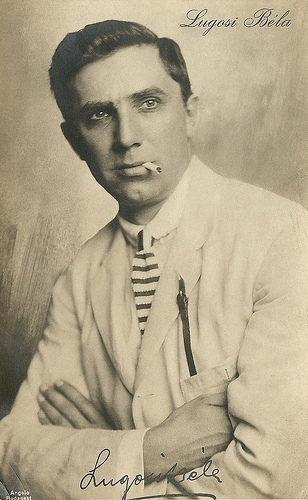
Hungarian postcard. Photo: Atelier Angelo, Budapest. Collection: Didier Hanson.
Dr. Jekyll and Mr. Hyde
Béla Lugosi was born as Béla Ferenc Dezső Blaskó in 1882, the youngest of the four children of Paula de Vojnich and István Blaskó, a banker. His hometown was Lugos, in Austria–Hungary (now Lugoj in Romania), near the western border of Transylvania. Later he would base his last name on this town.
At the age of 12, Lugosi dropped out of school. He began his acting career probably in 1901 or 1902. His earliest known performances are small roles in plays and operettas in provincial theaters in the 1903–1904 season. He moved on to Shakespeare plays and played several major roles. In 1911 he moved to Budapest, where he worked for the National Theatre of Hungary in the period 1913–1919. Although Lugosi would later claim that he 'became the leading actor of Hungary's Royal National Theater', most of his roles were small or supporting parts.
During World War I, he served as an infantry lieutenant in the Austro-Hungarian Army from 1914 to 1916. There he rose to the rank of captain in the ski patrol and was awarded a medal for being wounded at the Russian front. In 1917, Lugosi married Ilona Szmick. The couple divorced in 1920, reputedly over political differences with her parents.
In 1917 he made his film debut in Az ezredes/The Colonel (Mihály Kertész a.k.a. Michael Curtiz, 1917). In the next two years, Lugosi made 12 films in Hungary, credited as Arisztid Olt, including Nászdal/The Wedding March (Alfréd Deésy, 1917) and Lulu (Michael Curtiz, 1918). After the collapse of Béla Kun's Hungarian Soviet Republic in 1919, leftists and trade unionists became vulnerable. Due to his participation in the formation of an actors’ union, Lugosi was proscribed from acting and so had to leave his homeland.
He first went to Vienna, Austria, and then settled in Berlin, where he continued acting. In Germany, he appeared in 17 films, including Der Fluch der Menschheit/The Curse of Man (Richard Eichberg, 1920), Der Tanz auf dem Vulkan/Dance on the Volcano (Richard Eichberg, 1920), Hypnose/Hypnosis (Richard Eichberg, 1920) and Ihre Hoheit die Tänzerin/Her Highness the Dancer (Richard Eichberg, 1922), all with Lee Parry and Violetta Napierska .
Der Januskopf/The Head of Janus (F.W. Murnau, 1920) was an uncredited and apparently lost version of Robert Louis Stevenson's The Strange Case of Dr. Jekyll and Mr. Hyde, which featured Conrad Veidt . Well received films were also the Karl May adaptations Die Teufelsanbeter/The Devil Worshippers (Marie Luise Droop, 1920), Auf den Trümmern des Paradieses/On the Brink of Paradise (Josef Stein, 1920), and Die Todeskarawane/The Caravan of Death (Josef Stein, 1920), starring Carl de Vogt as Kara Ben Nemsi and also with the ill-fated Jewish actress Dora Gerson. Lugosi then left Germany as a crewman aboard a merchant ship. He had decided to emigrate to the United States.
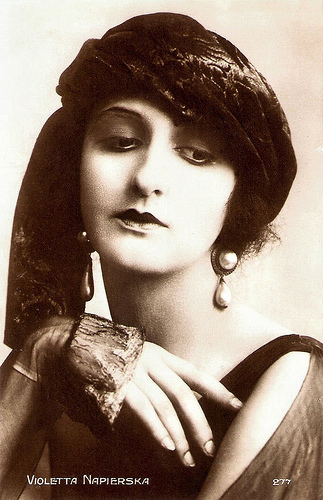
Violetta Napierska. French postcard by Cinémagazine-Edition, Paris, no. 277.
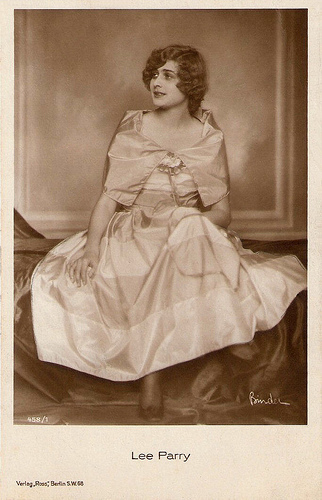
Lee Parry . German postcard by Ross Verlag, no. 458/1, 1919-1924 (at the backside of the card is hand written: 1920). Photo: Alex Binder.
Dracula
On his arrival in America in 1921, Béla Lugosi worked for some time as a labourer, then entered the theatre in New York City's Hungarian immigrant colony. With fellow Hungarian actors he formed a small stock company that toured Eastern cities, playing for immigrant audiences. In 1922, he acted in his first Broadway play, The Red Poppy. Three more parts came in 1925–1926, including a five-month run in the comedy-fantasy The Devil in the Cheese.
His first American film role came in the melodrama The Silent Command (J. Gordon Edwards, 1923) with Edmund Lowe. Several more silent roles followed, as villains or continental types, all in productions made in the New York area. In the summer of 1927, Lugosi was approached to star as a sophisticated vampire in a Broadway production of Dracula (1927-1928) adapted by Hamilton Deane and John L. Balderston from Bram Stoker's novel. The Horace Liveright production was successful, running 261 performances before touring.
Lugosi declared his intention to become a U.S. citizen in 1928, and in 1931, he was naturalized. Lugosi was soon called to Hollywood for character parts in early talkies, such as Prisoners (William A Seiter, 1929) and The Thirteenth Chair (Tod Browning, 1929). He took his place in Hollywood society and scandal in 1929 when he married wealthy San Francisco widow Beatrice Weeks, but she filed for divorce four months later. Weeks cited actress Clara Bow as the ‘other woman’.
Despite his critically acclaimed performance on stage, Lugosi was not Universal Pictures’ first choice for the role of Dracula when the company optioned the rights to the Deane play and began production in 1930. A persistent rumour asserts that director Tod Browning's long-time collaborator, Lon Chaney , was Universal's first choice for the role, and that Lugosi was chosen only due to Chaney's death shortly before production.
Wikipedia notes that this is questionable, because Browning was only a last-minute choice as director for Dracula after the death of the original director, Paul Leni. Lugosi appeared in Dracula (Tod Browning, 1931) with minimal make-up, using his natural, heavily accented voice. With the instant and worldwide success of the film, Universal Studios had found their new horror star. As his son Bela Lugosi Jr. writes on his father’s official website: “His slicked hair, clean-shaven and handsome face, burning eyes, and courtly manner are the appearance of what Dracula will forever be.”
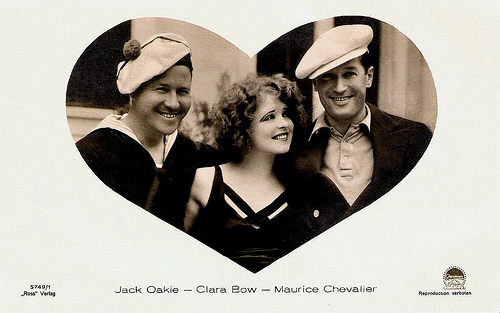
Clara Bow with Maurice Chevalier and Jack Oakie. German postcard by Ross Verlag, no. 5749/1, 1930-1931. Photo: Paramount. Publicity still for Paramount on Parade (Dorothy Arzner a.o., 1930).
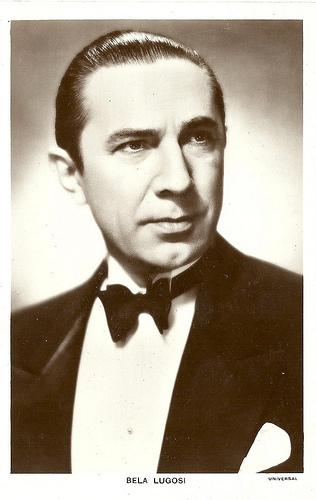
British postcard in the Picturegoer series. Photo: Universal. Collection: Didier Hanson.
Son of Frankenstein
In 1933 Béla Lugosi married 19-year-old Lillian Arch, the daughter of Hungarian immigrants. All seemed to go well. He appeared as Dr. Mirakle in Murders in the Rue Morgue (Robert Florey, 1932), as Sayer of Law in Island of the Lost Souls (Erle C. Kenton, 1932) opposite Charles Laughton , and as Ygor in Son of Frankenstein (Rowland V. Lee, 1939) all for Universal, and as Murder Legendre in the independent White Zombie (Victor Halperin, 1932).
Five films at Universal — The Black Cat (Edgar G. Ulmer, 1934), The Raven (Lew Landers, 1935), The Invisible Ray (Lambert Hillyer, 1936), Son of Frankenstein (Rowland V. Lee, 1939), Black Friday (Arthur Lubin, 1940) plus minor cameo performances in Gift of Gab (Karl Freund, 1934) and two at RKO Pictures, You'll Find Out (David Butler, 1940) and The Body Snatcher (Robert Wise, 1945) — paired Lugosi with Boris Karloff.
Despite the relative size of their roles, Lugosi inevitably got second billing, below Karloff. Lugosi himself perpetrated the myth that he had quit the role of the monster in Frankenstein (James Whale, 1931), which is untrue. Originally, director Robert Florey wanted him to play Dr. Frankenstein, but producer Carl Laemmle Jr. didn't want Lugosi in that role, so he was relocated to the monster part. Lugosi was unhappy with playing the clodding, mute monster under heavy make-up and complained. He had filmed some screen-tests with Florey, but Laemmle Jr. didn't like what he saw and fired both Florey and Lugosi.
In interviews, Boris Karloff suggested that Lugosi was initially mistrustful of him when they acted together, believing that the Englishman would attempt to upstage him. When this proved not to be the case, Lugosi settled down and they worked together amicably. Through his association with Dracula, Béla Lugosi found himself typecast as a horror villain. His accent, while a part of his image, limited the roles he could play. He attempted to break type by auditioning for other roles, and he did play the elegant, somewhat hot-tempered Gen. Nicholas Strenovsky-Petronovich in International House (A. Edward Sutherland, 1933). Universal tried to give Lugosi more heroic roles, as in The Black Cat, The Invisible Ray, and a romantic role in the adventure serial The Return of Chandu (Ray Taylor, 1934), but his typecasting problem was too entrenched for those roles to help.
Lugosi, experienced a severe career decline despite his popularity with audiences. A number of factors worked against Lugosi's career in the mid-1930s. Universal changed management in 1936, and because of a British ban on horror films, dropped them from their production schedule; Lugosi found himself consigned to Universal's non-horror B-film unit, at times in small roles where he was obviously used for ‘name value’ only. He accepted leading roles in low-budget thrillers from independent producers like Nat Levine, Sol Lesser, and Sam Katzman. The exposure helped Lugosi financially but not artistically. Lugosi tried to keep busy with stage work, but had to borrow money from the Actors' Fund to pay hospital bills when his only child, Bela George Lugosi, was born in 1938. It illustrates why he helped to organize the Screen Actors Guild in the 1930s.
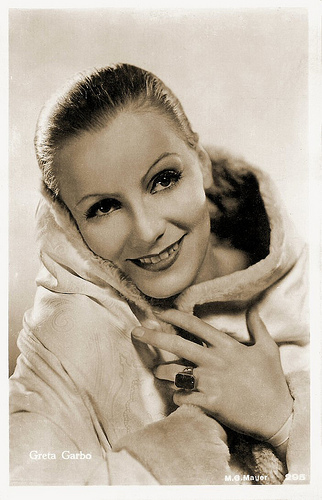
Greta Garbo . Dutch postcard by JosPe, no. 295. Photo: Metro-Goldwyn-Mayer (MGM).
Hollywood's Poverty Row
Béla Lugosi’s career was given a second chance by Universal's Son of Frankenstein (Rowland V. Lee, 1939), when he played the character role of Ygor, who uses the Monster for his own revenge, in heavy makeup and beard. The same year he played a straight character role as a stern commissar in Ninotchka (Ernst Lubitsch, 1939), starring Greta Garbo .
This small but prestigious role could have been a turning point for the actor, but within the year he was back on Hollywood's Poverty Row, playing leads for Sam Katzman. These horror, comedy and mystery B-films were released by Monogram Pictures. At Universal, he often received star billing for what amounted to a supporting part. Ostensibly due to injuries received during military service, Lugosi developed severe, chronic sciatica, for which he was treated with opiates. The growth of his dependence on morphine and methadone, was directly proportional to the dwindling of screen offers.
In 1943, he finally played the role of Frankenstein's monster in Universal's Frankenstein Meets the Wolfman (Roy William Neill, 1943) opposite Lon Chaney Jr. He also came to recreate the role of Dracula a second and last time on film in Abbott and Costello Meet Frankenstein (Charles Barton, 1948). It was his last ‘A’ movie.
For the remainder of his life he appeared in obscure, low-budget features. While in England to play a six-month tour of Dracula in 1951, he co-starred in a lowbrow film comedy, Mother Riley Meets the Vampire/Vampire over London (John Gillin, 1951). Late in his life, Bela Lugosi again received star billing when fan Ed Wood, nicknamed ‘Worst Director of All Time’, offered him roles in his films, such as Glen or Glenda (Edward D. Wood Jr., 1953) and as a Dr. Frankenstein-like mad scientist in Bride of the Monster (Edward D. Wood Jr., 1955).
During post-production of the latter, Lugosi decided to seek treatment for his drug addiction. Following his treatment, Lugosi made one final film, The Black Sleep (Reginald Le Borg, 1956), which was released in the summer of 1956 through United Artists with a promotional campaign that included several personal appearances. To his disappointment, however, his role in this film was of a mute, with no dialogue.
Béla Lugosi and his wife Lilian had divorced in 1953. Béla was jealous over Lillian taking a full-time job as an assistant to Brian Donlevy on the sets and studios for Donlevy's radio and television series Dangerous Assignment. Lillian eventually did marry Donlevy, in 1966. In 1955 Lugosi married fan Hope Lininger, his fifth wife. A year later, Lugosi died of a heart attack in 1956, while lying on a couch in his Los Angeles home. He was 73.
Lugosi was buried wearing one of the Dracula Cape costumes, per the request of his son. Ed Wood's Plan 9 from Outer Space (Edward D. Wood Jr, 1959.) with a few minutes of silent footage of Lugosi in his Dracula cape was released posthumously. In 1994, Lugosi was played by Martin Landau in Tim Burton's Ed Wood (1994), for which Landau received an Academy Award for Best Supporting Actor. Johnny Depp, who starred as Wood in the film, purchased Lugosi's Los Angeles home.
Mirror scene from Dracula (1931). Source: Son of Jack 3 (YouTube).
Trailer for White Zombie (1932). Source: Sinister Cinema (YouTube).
Trailer for Mark of the Vampire (1935). Source: Sinister Cinema (YouTube).
Trailer for Bride of the Monster (1955). Source: Captain Bijou (YouTube).
Source: Bela Lugosi, Jr. (Official Bela Lugosi website), (IMDb), Wikipedia and .

Hungarian postcard. Photo: Atelier Angelo, Budapest. Collection: Didier Hanson.
Dr. Jekyll and Mr. Hyde
Béla Lugosi was born as Béla Ferenc Dezső Blaskó in 1882, the youngest of the four children of Paula de Vojnich and István Blaskó, a banker. His hometown was Lugos, in Austria–Hungary (now Lugoj in Romania), near the western border of Transylvania. Later he would base his last name on this town.
At the age of 12, Lugosi dropped out of school. He began his acting career probably in 1901 or 1902. His earliest known performances are small roles in plays and operettas in provincial theaters in the 1903–1904 season. He moved on to Shakespeare plays and played several major roles. In 1911 he moved to Budapest, where he worked for the National Theatre of Hungary in the period 1913–1919. Although Lugosi would later claim that he 'became the leading actor of Hungary's Royal National Theater', most of his roles were small or supporting parts.
During World War I, he served as an infantry lieutenant in the Austro-Hungarian Army from 1914 to 1916. There he rose to the rank of captain in the ski patrol and was awarded a medal for being wounded at the Russian front. In 1917, Lugosi married Ilona Szmick. The couple divorced in 1920, reputedly over political differences with her parents.
In 1917 he made his film debut in Az ezredes/The Colonel (Mihály Kertész a.k.a. Michael Curtiz, 1917). In the next two years, Lugosi made 12 films in Hungary, credited as Arisztid Olt, including Nászdal/The Wedding March (Alfréd Deésy, 1917) and Lulu (Michael Curtiz, 1918). After the collapse of Béla Kun's Hungarian Soviet Republic in 1919, leftists and trade unionists became vulnerable. Due to his participation in the formation of an actors’ union, Lugosi was proscribed from acting and so had to leave his homeland.
He first went to Vienna, Austria, and then settled in Berlin, where he continued acting. In Germany, he appeared in 17 films, including Der Fluch der Menschheit/The Curse of Man (Richard Eichberg, 1920), Der Tanz auf dem Vulkan/Dance on the Volcano (Richard Eichberg, 1920), Hypnose/Hypnosis (Richard Eichberg, 1920) and Ihre Hoheit die Tänzerin/Her Highness the Dancer (Richard Eichberg, 1922), all with Lee Parry and Violetta Napierska .
Der Januskopf/The Head of Janus (F.W. Murnau, 1920) was an uncredited and apparently lost version of Robert Louis Stevenson's The Strange Case of Dr. Jekyll and Mr. Hyde, which featured Conrad Veidt . Well received films were also the Karl May adaptations Die Teufelsanbeter/The Devil Worshippers (Marie Luise Droop, 1920), Auf den Trümmern des Paradieses/On the Brink of Paradise (Josef Stein, 1920), and Die Todeskarawane/The Caravan of Death (Josef Stein, 1920), starring Carl de Vogt as Kara Ben Nemsi and also with the ill-fated Jewish actress Dora Gerson. Lugosi then left Germany as a crewman aboard a merchant ship. He had decided to emigrate to the United States.

Violetta Napierska. French postcard by Cinémagazine-Edition, Paris, no. 277.

Lee Parry . German postcard by Ross Verlag, no. 458/1, 1919-1924 (at the backside of the card is hand written: 1920). Photo: Alex Binder.
Dracula
On his arrival in America in 1921, Béla Lugosi worked for some time as a labourer, then entered the theatre in New York City's Hungarian immigrant colony. With fellow Hungarian actors he formed a small stock company that toured Eastern cities, playing for immigrant audiences. In 1922, he acted in his first Broadway play, The Red Poppy. Three more parts came in 1925–1926, including a five-month run in the comedy-fantasy The Devil in the Cheese.
His first American film role came in the melodrama The Silent Command (J. Gordon Edwards, 1923) with Edmund Lowe. Several more silent roles followed, as villains or continental types, all in productions made in the New York area. In the summer of 1927, Lugosi was approached to star as a sophisticated vampire in a Broadway production of Dracula (1927-1928) adapted by Hamilton Deane and John L. Balderston from Bram Stoker's novel. The Horace Liveright production was successful, running 261 performances before touring.
Lugosi declared his intention to become a U.S. citizen in 1928, and in 1931, he was naturalized. Lugosi was soon called to Hollywood for character parts in early talkies, such as Prisoners (William A Seiter, 1929) and The Thirteenth Chair (Tod Browning, 1929). He took his place in Hollywood society and scandal in 1929 when he married wealthy San Francisco widow Beatrice Weeks, but she filed for divorce four months later. Weeks cited actress Clara Bow as the ‘other woman’.
Despite his critically acclaimed performance on stage, Lugosi was not Universal Pictures’ first choice for the role of Dracula when the company optioned the rights to the Deane play and began production in 1930. A persistent rumour asserts that director Tod Browning's long-time collaborator, Lon Chaney , was Universal's first choice for the role, and that Lugosi was chosen only due to Chaney's death shortly before production.
Wikipedia notes that this is questionable, because Browning was only a last-minute choice as director for Dracula after the death of the original director, Paul Leni. Lugosi appeared in Dracula (Tod Browning, 1931) with minimal make-up, using his natural, heavily accented voice. With the instant and worldwide success of the film, Universal Studios had found their new horror star. As his son Bela Lugosi Jr. writes on his father’s official website: “His slicked hair, clean-shaven and handsome face, burning eyes, and courtly manner are the appearance of what Dracula will forever be.”

Clara Bow with Maurice Chevalier and Jack Oakie. German postcard by Ross Verlag, no. 5749/1, 1930-1931. Photo: Paramount. Publicity still for Paramount on Parade (Dorothy Arzner a.o., 1930).

British postcard in the Picturegoer series. Photo: Universal. Collection: Didier Hanson.
Son of Frankenstein
In 1933 Béla Lugosi married 19-year-old Lillian Arch, the daughter of Hungarian immigrants. All seemed to go well. He appeared as Dr. Mirakle in Murders in the Rue Morgue (Robert Florey, 1932), as Sayer of Law in Island of the Lost Souls (Erle C. Kenton, 1932) opposite Charles Laughton , and as Ygor in Son of Frankenstein (Rowland V. Lee, 1939) all for Universal, and as Murder Legendre in the independent White Zombie (Victor Halperin, 1932).
Five films at Universal — The Black Cat (Edgar G. Ulmer, 1934), The Raven (Lew Landers, 1935), The Invisible Ray (Lambert Hillyer, 1936), Son of Frankenstein (Rowland V. Lee, 1939), Black Friday (Arthur Lubin, 1940) plus minor cameo performances in Gift of Gab (Karl Freund, 1934) and two at RKO Pictures, You'll Find Out (David Butler, 1940) and The Body Snatcher (Robert Wise, 1945) — paired Lugosi with Boris Karloff.
Despite the relative size of their roles, Lugosi inevitably got second billing, below Karloff. Lugosi himself perpetrated the myth that he had quit the role of the monster in Frankenstein (James Whale, 1931), which is untrue. Originally, director Robert Florey wanted him to play Dr. Frankenstein, but producer Carl Laemmle Jr. didn't want Lugosi in that role, so he was relocated to the monster part. Lugosi was unhappy with playing the clodding, mute monster under heavy make-up and complained. He had filmed some screen-tests with Florey, but Laemmle Jr. didn't like what he saw and fired both Florey and Lugosi.
In interviews, Boris Karloff suggested that Lugosi was initially mistrustful of him when they acted together, believing that the Englishman would attempt to upstage him. When this proved not to be the case, Lugosi settled down and they worked together amicably. Through his association with Dracula, Béla Lugosi found himself typecast as a horror villain. His accent, while a part of his image, limited the roles he could play. He attempted to break type by auditioning for other roles, and he did play the elegant, somewhat hot-tempered Gen. Nicholas Strenovsky-Petronovich in International House (A. Edward Sutherland, 1933). Universal tried to give Lugosi more heroic roles, as in The Black Cat, The Invisible Ray, and a romantic role in the adventure serial The Return of Chandu (Ray Taylor, 1934), but his typecasting problem was too entrenched for those roles to help.
Lugosi, experienced a severe career decline despite his popularity with audiences. A number of factors worked against Lugosi's career in the mid-1930s. Universal changed management in 1936, and because of a British ban on horror films, dropped them from their production schedule; Lugosi found himself consigned to Universal's non-horror B-film unit, at times in small roles where he was obviously used for ‘name value’ only. He accepted leading roles in low-budget thrillers from independent producers like Nat Levine, Sol Lesser, and Sam Katzman. The exposure helped Lugosi financially but not artistically. Lugosi tried to keep busy with stage work, but had to borrow money from the Actors' Fund to pay hospital bills when his only child, Bela George Lugosi, was born in 1938. It illustrates why he helped to organize the Screen Actors Guild in the 1930s.

Greta Garbo . Dutch postcard by JosPe, no. 295. Photo: Metro-Goldwyn-Mayer (MGM).
Hollywood's Poverty Row
Béla Lugosi’s career was given a second chance by Universal's Son of Frankenstein (Rowland V. Lee, 1939), when he played the character role of Ygor, who uses the Monster for his own revenge, in heavy makeup and beard. The same year he played a straight character role as a stern commissar in Ninotchka (Ernst Lubitsch, 1939), starring Greta Garbo .
This small but prestigious role could have been a turning point for the actor, but within the year he was back on Hollywood's Poverty Row, playing leads for Sam Katzman. These horror, comedy and mystery B-films were released by Monogram Pictures. At Universal, he often received star billing for what amounted to a supporting part. Ostensibly due to injuries received during military service, Lugosi developed severe, chronic sciatica, for which he was treated with opiates. The growth of his dependence on morphine and methadone, was directly proportional to the dwindling of screen offers.
In 1943, he finally played the role of Frankenstein's monster in Universal's Frankenstein Meets the Wolfman (Roy William Neill, 1943) opposite Lon Chaney Jr. He also came to recreate the role of Dracula a second and last time on film in Abbott and Costello Meet Frankenstein (Charles Barton, 1948). It was his last ‘A’ movie.
For the remainder of his life he appeared in obscure, low-budget features. While in England to play a six-month tour of Dracula in 1951, he co-starred in a lowbrow film comedy, Mother Riley Meets the Vampire/Vampire over London (John Gillin, 1951). Late in his life, Bela Lugosi again received star billing when fan Ed Wood, nicknamed ‘Worst Director of All Time’, offered him roles in his films, such as Glen or Glenda (Edward D. Wood Jr., 1953) and as a Dr. Frankenstein-like mad scientist in Bride of the Monster (Edward D. Wood Jr., 1955).
During post-production of the latter, Lugosi decided to seek treatment for his drug addiction. Following his treatment, Lugosi made one final film, The Black Sleep (Reginald Le Borg, 1956), which was released in the summer of 1956 through United Artists with a promotional campaign that included several personal appearances. To his disappointment, however, his role in this film was of a mute, with no dialogue.
Béla Lugosi and his wife Lilian had divorced in 1953. Béla was jealous over Lillian taking a full-time job as an assistant to Brian Donlevy on the sets and studios for Donlevy's radio and television series Dangerous Assignment. Lillian eventually did marry Donlevy, in 1966. In 1955 Lugosi married fan Hope Lininger, his fifth wife. A year later, Lugosi died of a heart attack in 1956, while lying on a couch in his Los Angeles home. He was 73.
Lugosi was buried wearing one of the Dracula Cape costumes, per the request of his son. Ed Wood's Plan 9 from Outer Space (Edward D. Wood Jr, 1959.) with a few minutes of silent footage of Lugosi in his Dracula cape was released posthumously. In 1994, Lugosi was played by Martin Landau in Tim Burton's Ed Wood (1994), for which Landau received an Academy Award for Best Supporting Actor. Johnny Depp, who starred as Wood in the film, purchased Lugosi's Los Angeles home.
Mirror scene from Dracula (1931). Source: Son of Jack 3 (YouTube).
Trailer for White Zombie (1932). Source: Sinister Cinema (YouTube).
Trailer for Mark of the Vampire (1935). Source: Sinister Cinema (YouTube).
Trailer for Bride of the Monster (1955). Source: Captain Bijou (YouTube).
Source: Bela Lugosi, Jr. (Official Bela Lugosi website), (IMDb), Wikipedia and .
Published on June 25, 2016 22:00
June 24, 2016
Lars Hanson
Today starts the 30th edition of Cinema Ritrovata. Till 2 July we're in Bologna, Italy, to attend the festival. One of the programme sections is 100 YEARS AGO: A SELECTION FROM 1916. Included is the Swedish production Vingarne/Wings (Mauritz Stiller, 1916), starring Lars Hanson (1886-1965). The highly successful Swedish actor is dearly remembered for his roles in several classic films of the silent era, which he made in Scandinavia as well as in Hollywood. The American silent film Flesh and the Devil (Clarence Brown, 1926), starring Hanson, John Gilbert and Greta Garbo, will also be shown at Cinema Ritrovato.
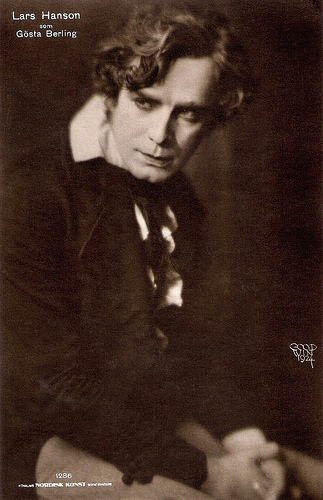
Lars Hanson as Gösta Berling in Gösta Berlings saga (1924). Swedish postcard by Förlag Nordisk Konst, Stockholm, no. 1286. Photo: Goodwin, 1924.
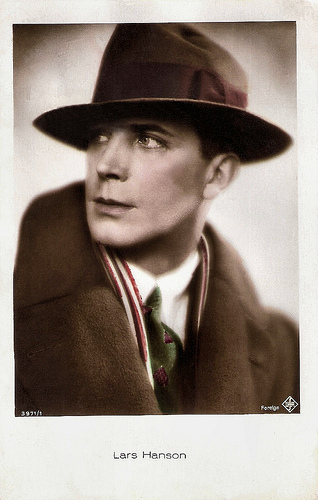
British postcard by Ross Verlag, no. 3971/1, 1928-1929. Photo: Ufa.
Shakespearean Actor
Lars Mauritz Hanson was born in Göteborg, Sweden in 1886. He studied drama in Helsinki, Finland and at the Dramatens elevskola in Stockholm. He began his career on the stages of Sweden as a Shakespearean actor, appearing in such classics as Othello and Hamlet. In 1906, he joined the prominent Stockholm Royal Dramatic Theatre.
In 1915, Hanson made his film debut in Dolken/The Dagger (Mauritz Stiller, 1915). He worked again with Stiller on Vingarne/The Wings (Mauritz Stiller, 1916). The story is that of a conniving countess (played by Lili Bech ) coming between a sculptor, Claude Zoret (Egil Eide), and his model and suggested lover, Mikaël (Lars Hanson), ultimately leading to Zoret's death in a raging storm at the base of a statue of Mikaël as the mythological Icarus. Vingarne is notable for its innovative use of a framing story and telling the plot primarily through the use of flashbacks.
His popularity as a leading man in his homeland grew with ensuing roles in films like Balettprimadonnan/Anjala the Dancer (Mauritz Stiller, 1916), Therèse (Victor Sjöström, 1917), Tösen från Stormyrtorpet/The Girl From Stormycroft (Victor Sjöström, 1917) and Sången om den eldröda blomman/Song of the Scarlet Flower (Mauritz Stiller, 1919).
A highlight was the sophisticated comedy Erotikon/Seduction (Mauritz Stiller, 1920). The story revolves around an entomology professor (Anders de Wahl) obsessed with the sexual life of bugs, and his easygoing wife (Tora Teje) who is courted by two suitors (Lars Hanson and Vilhelm Bryde). The film became a commercial success in Sweden in 1920 and was sold to 45 markets abroad.
In Synnöva Solbakken/The Girl of Solbakken (John W. Brunius, 1919) and Fiskebyn/The Fishing Village (Mauritz Stiller, 1920), Hanson starred opposite the wife of influential director Gustaf Molander, Karin Molander . They fell in love, and in 1922, Hanson and Molander were married. The couple remained together until Hanson's death in 1965.
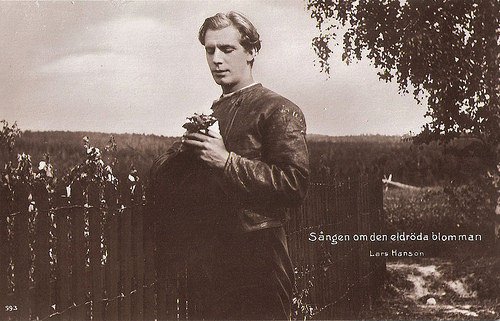
Swedish postcard by Forlag Nordisk Konst, Stockholm, no. 993. Photo: Svenska Biografteatern, Stockholm. Publicity still for Sången om den eldröda blomman/Flame of Life (Mauritz Stiller, 1919).
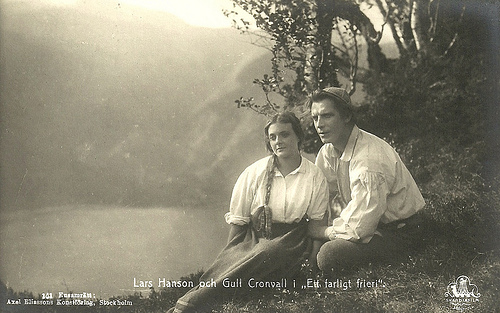
Swedish postcard by Axel Eliassons Konstforlag, Stockholm. Photo: Skandia Film, Stockholm. Lars Hanson and Gull Cronvall in Ett farligt frieri/A Dangerous Proposal (Rune Carlsten 1919). The story deals with Tore, a smallholder's son (Hanson), in love with Aslaug, a farmer's daughter (Cronvall) whose father Knut (Theodor Blich) has ambitious plans to marry her to the son of the wealthiest farmer around. Even after Knut and Aslaug's brothers have beaten Tore black and blue, he persists in visiting Aslaug, even climbing a giant wall of rock...
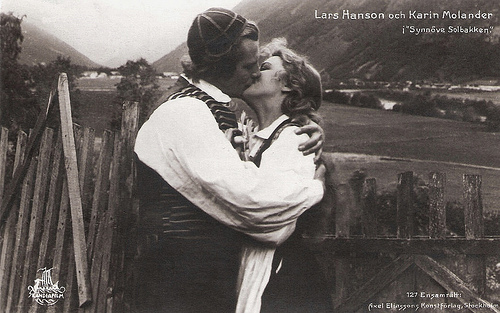
Swedish postcard by Axel Eliassons Konstförlag, Stockholm, no. 127. Photo: Skandiafilm. Still for Synnöva Solbakken/The Girl of Solbakken (1919) with Karin Molander . Sent by mail in Norway in 1920.
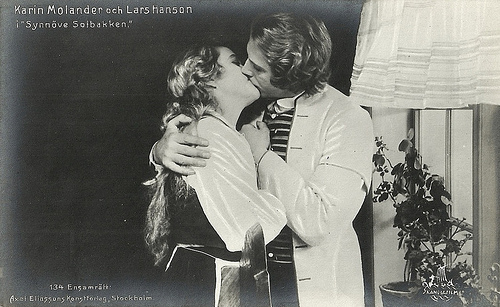
Swedish postcard by Axel Eliassons Konstförlag, Stockholm, no. 134. Photo: Skandia-Film. Publicity still for Synnöve Solbakken (John W. Brunius, 1919), starring Lars Hanson and Karin Molander , and adapted from Bjørnstjerne Bjørnson's novel (1857).
Master of Disguise
Lars Hanson was one of the greatest actors in Swedish theatre, starring in plays by William Shakespeare and Eugene O’Neill. He was a master of disguise for his many roles, building his body with implants in his shoes and several layers of clothing, starving himself, and bruise his face with a shoe brush.
While already a well established popular film actor in Sweden and much of continental Europe, Lars Hanson gained greater international recognition for his role as the title character in Gösta Berlings saga/The Story of Gösta Berling (Mauritz Stiller, 1924).
The film is an adaptation of a book written by the famous Swedish author Selma Lagerloff. It tells the epic story of Gösta, a alcoholic minister who is expelled from the priesthood for his habit, but the bigger problem with his parish is his truthfulness.
Gösta gets a new job in Värmland, a state managed by the people of Ekeby. Gösta's strong personality and his special charm with women bring him many problems. Two powerful families, full of hypocrisy, lies and adultery, rule two estates in Värmland and they surround Gösta with intrigue and problems.
At the end of the film he gets his redemption from the hand of Elisabeth. This was a role by Greta Garbo in her first major screen appearance.
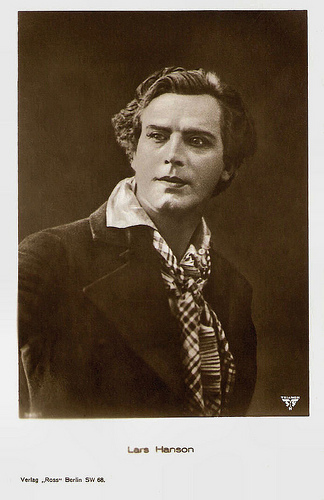
German postcard by Ross Verlag, Berlin. Photo: Trianon.
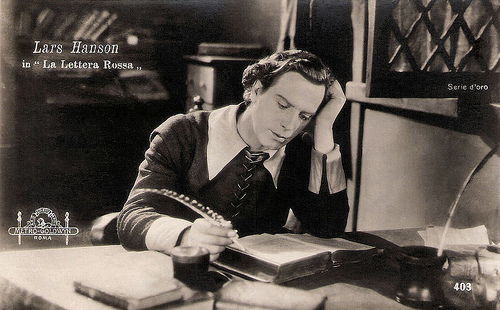
Italian postcard by Ballerini & Fratini, Firenze, no. 403. Photo: Metro-Goldwyn-Mayer, Roma. Lars Hanson as Reverend Arthur Dimmesdale in the MGM period piece The Scarlet Letter (Victor Sjöström, 1926), set in the era of the Puritans.
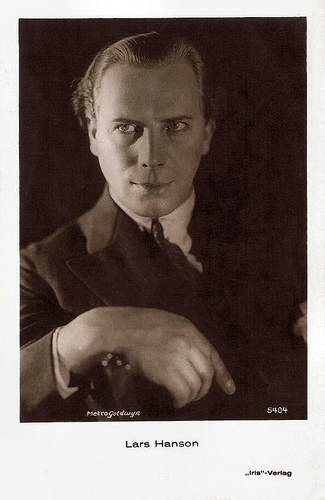
Austrian postcard by Iris-Verlag, no. 5404. Photo: Metro Goldwyn.
Liability in American films
At the request of American actress Lillian Gish, Lars Hanson went to Hollywood in 1926 (the same year as Garbo went to the USA) to star opposite Gish in the film version of The Scarlet Letter (Victor Sjöström, 1926). Producer Louis B. Mayer was reluctant on using Gish, fearing opposition from church groups. The film was announced as "It's a real 'A' picture", taking advantage of the 'A' for Adultery. The film made a profit of $296,000.
Next Hanson was paired with Greta Garbo in MGM's box-office hit Flesh and the Devil (Clarence Brown, 1927), which also starred Garbo's offscreen lover John Gilbert, and in The Divine Woman (Victor Sjöström, 1928). The plot of the latter is loosely based on the early life of the French actress Sarah Bernhardt . Sadly, the film is considered lost, only some segments survive.
Sjöström also directed Hanson in a performance opposite Lillian Gish in The Wind (1928), one of the last silent films released by Metro-Goldwyn-Mayer. At its time the film was simultaneously panned and hailed by American critics, and its late release at the dawn of the sound era contributed to a net loss for the production. However, the film had significant critical and considerable commercial success in Europe. The Wind is now considered one of the great masterpieces of the silent era.
Seeing that his heavy Swedish accent might be a liability in American films, Lars Hanson returned to Europe. He starred in the aptly titled German war drama Heimkehr/Homecoming (Joe May, 1928) He co-starred with Gustav Fröhlich as two prisoners of war who are bloodbrothers but then Fröhlich falls in love with Hanson's wife (Dita Parlo).
Hanson continued to appear in Swedish films like the war film Första divisionen/First Division (Hasse Ekman, 1941) and Det brinner en eld/There Burned a Flame (Gustav Molander, 1943). His last performance was in the film Dårskapens hus/The Nuthouse (Hasse Ekman, 1951).
Lars Hanson died in Stockholm, Sweden in 1965. He passed away after a short illness at the age of 78.
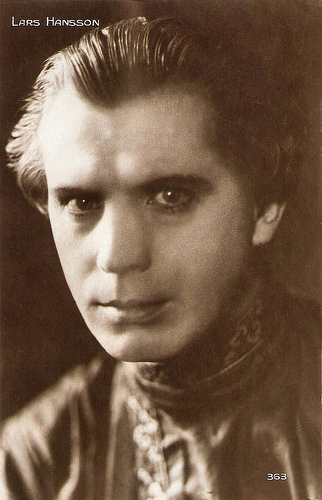
French postcard by Cinémagazine-Edition, no. 363.
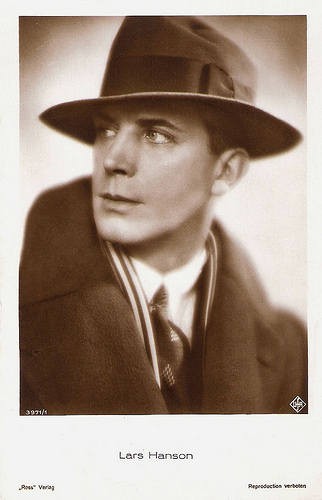
German postcard by Ross Verlag, no. 3971/1, 1928-1929. Photo: Ufa.
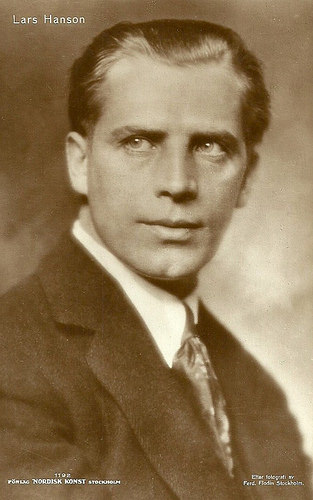
Swedish postcard by Förlag Nordisk Konst, Stockholm, no. 1192. Photo: Ferd. Flodin, Stockholm.
Sources: Wikipedia and .

Lars Hanson as Gösta Berling in Gösta Berlings saga (1924). Swedish postcard by Förlag Nordisk Konst, Stockholm, no. 1286. Photo: Goodwin, 1924.

British postcard by Ross Verlag, no. 3971/1, 1928-1929. Photo: Ufa.
Shakespearean Actor
Lars Mauritz Hanson was born in Göteborg, Sweden in 1886. He studied drama in Helsinki, Finland and at the Dramatens elevskola in Stockholm. He began his career on the stages of Sweden as a Shakespearean actor, appearing in such classics as Othello and Hamlet. In 1906, he joined the prominent Stockholm Royal Dramatic Theatre.
In 1915, Hanson made his film debut in Dolken/The Dagger (Mauritz Stiller, 1915). He worked again with Stiller on Vingarne/The Wings (Mauritz Stiller, 1916). The story is that of a conniving countess (played by Lili Bech ) coming between a sculptor, Claude Zoret (Egil Eide), and his model and suggested lover, Mikaël (Lars Hanson), ultimately leading to Zoret's death in a raging storm at the base of a statue of Mikaël as the mythological Icarus. Vingarne is notable for its innovative use of a framing story and telling the plot primarily through the use of flashbacks.
His popularity as a leading man in his homeland grew with ensuing roles in films like Balettprimadonnan/Anjala the Dancer (Mauritz Stiller, 1916), Therèse (Victor Sjöström, 1917), Tösen från Stormyrtorpet/The Girl From Stormycroft (Victor Sjöström, 1917) and Sången om den eldröda blomman/Song of the Scarlet Flower (Mauritz Stiller, 1919).
A highlight was the sophisticated comedy Erotikon/Seduction (Mauritz Stiller, 1920). The story revolves around an entomology professor (Anders de Wahl) obsessed with the sexual life of bugs, and his easygoing wife (Tora Teje) who is courted by two suitors (Lars Hanson and Vilhelm Bryde). The film became a commercial success in Sweden in 1920 and was sold to 45 markets abroad.
In Synnöva Solbakken/The Girl of Solbakken (John W. Brunius, 1919) and Fiskebyn/The Fishing Village (Mauritz Stiller, 1920), Hanson starred opposite the wife of influential director Gustaf Molander, Karin Molander . They fell in love, and in 1922, Hanson and Molander were married. The couple remained together until Hanson's death in 1965.

Swedish postcard by Forlag Nordisk Konst, Stockholm, no. 993. Photo: Svenska Biografteatern, Stockholm. Publicity still for Sången om den eldröda blomman/Flame of Life (Mauritz Stiller, 1919).

Swedish postcard by Axel Eliassons Konstforlag, Stockholm. Photo: Skandia Film, Stockholm. Lars Hanson and Gull Cronvall in Ett farligt frieri/A Dangerous Proposal (Rune Carlsten 1919). The story deals with Tore, a smallholder's son (Hanson), in love with Aslaug, a farmer's daughter (Cronvall) whose father Knut (Theodor Blich) has ambitious plans to marry her to the son of the wealthiest farmer around. Even after Knut and Aslaug's brothers have beaten Tore black and blue, he persists in visiting Aslaug, even climbing a giant wall of rock...

Swedish postcard by Axel Eliassons Konstförlag, Stockholm, no. 127. Photo: Skandiafilm. Still for Synnöva Solbakken/The Girl of Solbakken (1919) with Karin Molander . Sent by mail in Norway in 1920.

Swedish postcard by Axel Eliassons Konstförlag, Stockholm, no. 134. Photo: Skandia-Film. Publicity still for Synnöve Solbakken (John W. Brunius, 1919), starring Lars Hanson and Karin Molander , and adapted from Bjørnstjerne Bjørnson's novel (1857).
Master of Disguise
Lars Hanson was one of the greatest actors in Swedish theatre, starring in plays by William Shakespeare and Eugene O’Neill. He was a master of disguise for his many roles, building his body with implants in his shoes and several layers of clothing, starving himself, and bruise his face with a shoe brush.
While already a well established popular film actor in Sweden and much of continental Europe, Lars Hanson gained greater international recognition for his role as the title character in Gösta Berlings saga/The Story of Gösta Berling (Mauritz Stiller, 1924).
The film is an adaptation of a book written by the famous Swedish author Selma Lagerloff. It tells the epic story of Gösta, a alcoholic minister who is expelled from the priesthood for his habit, but the bigger problem with his parish is his truthfulness.
Gösta gets a new job in Värmland, a state managed by the people of Ekeby. Gösta's strong personality and his special charm with women bring him many problems. Two powerful families, full of hypocrisy, lies and adultery, rule two estates in Värmland and they surround Gösta with intrigue and problems.
At the end of the film he gets his redemption from the hand of Elisabeth. This was a role by Greta Garbo in her first major screen appearance.

German postcard by Ross Verlag, Berlin. Photo: Trianon.

Italian postcard by Ballerini & Fratini, Firenze, no. 403. Photo: Metro-Goldwyn-Mayer, Roma. Lars Hanson as Reverend Arthur Dimmesdale in the MGM period piece The Scarlet Letter (Victor Sjöström, 1926), set in the era of the Puritans.

Austrian postcard by Iris-Verlag, no. 5404. Photo: Metro Goldwyn.
Liability in American films
At the request of American actress Lillian Gish, Lars Hanson went to Hollywood in 1926 (the same year as Garbo went to the USA) to star opposite Gish in the film version of The Scarlet Letter (Victor Sjöström, 1926). Producer Louis B. Mayer was reluctant on using Gish, fearing opposition from church groups. The film was announced as "It's a real 'A' picture", taking advantage of the 'A' for Adultery. The film made a profit of $296,000.
Next Hanson was paired with Greta Garbo in MGM's box-office hit Flesh and the Devil (Clarence Brown, 1927), which also starred Garbo's offscreen lover John Gilbert, and in The Divine Woman (Victor Sjöström, 1928). The plot of the latter is loosely based on the early life of the French actress Sarah Bernhardt . Sadly, the film is considered lost, only some segments survive.
Sjöström also directed Hanson in a performance opposite Lillian Gish in The Wind (1928), one of the last silent films released by Metro-Goldwyn-Mayer. At its time the film was simultaneously panned and hailed by American critics, and its late release at the dawn of the sound era contributed to a net loss for the production. However, the film had significant critical and considerable commercial success in Europe. The Wind is now considered one of the great masterpieces of the silent era.
Seeing that his heavy Swedish accent might be a liability in American films, Lars Hanson returned to Europe. He starred in the aptly titled German war drama Heimkehr/Homecoming (Joe May, 1928) He co-starred with Gustav Fröhlich as two prisoners of war who are bloodbrothers but then Fröhlich falls in love with Hanson's wife (Dita Parlo).
Hanson continued to appear in Swedish films like the war film Första divisionen/First Division (Hasse Ekman, 1941) and Det brinner en eld/There Burned a Flame (Gustav Molander, 1943). His last performance was in the film Dårskapens hus/The Nuthouse (Hasse Ekman, 1951).
Lars Hanson died in Stockholm, Sweden in 1965. He passed away after a short illness at the age of 78.

French postcard by Cinémagazine-Edition, no. 363.

German postcard by Ross Verlag, no. 3971/1, 1928-1929. Photo: Ufa.

Swedish postcard by Förlag Nordisk Konst, Stockholm, no. 1192. Photo: Ferd. Flodin, Stockholm.
Sources: Wikipedia and .
Published on June 24, 2016 22:00
June 23, 2016
EFSP's Dazzling Dozen: Sex Kittens from France
Oh-la-la! The French woman has an international reputation of being risqué: French mademoiselles are more sensual, more naughty than our girls-next-door. Hollywood sustained that image with countless sexy parts for French actresses. But the French cinema did even more to keep the dream alive. Even in the 1930s, French films showed already brief glimpses of nudity and during the 1950s, Martine Carol and Françoise Arnoul paved the way for the rise of sex kitten Brigitte Bardot, the new look of French femininity. Here are 12 fabulous black and white postcards of French actresses of the 1950s, all photographed by Sam Lévin.
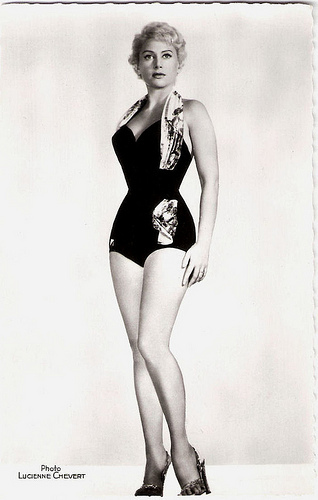
French postcard by Editions du Globe, Paris, no. 357. Photo: Lucienne Chevert.
Sex symbol Martine Carol (1920–1967) was one of the most beautiful women of the French cinema. During the early 1950s, she was a top box office draw as an elegant blonde seductress. Her private life was filled with turmoil including a suicide attempt, drug abuse, a kidnapping, and a mysterious death.
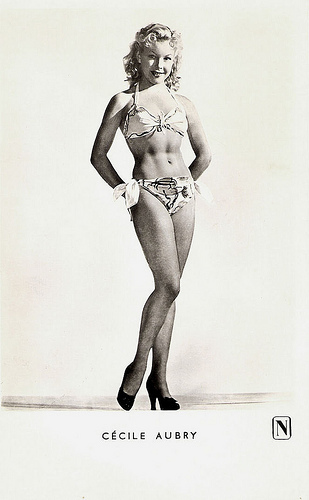
German postcard by Kunst und Bild, Berlin.
French actress, writer and director Cécile Aubry (1928-2010) was often seen as the predecessor of Brigitte Bardot as the French cinema's sex goddess. Her acting career was successful but brief: during the late 1940s through the mid-1950s.
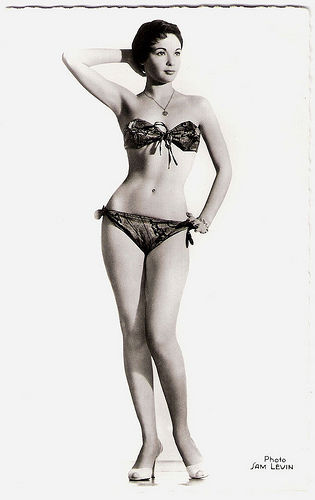
French postcard by Editions du Globe, no. 617. Photo: Sam Lévin, Paris.
Pretty and petite actress Françoise Arnoul (1931) was in the early 1950s presented as the new French sex symbol but soon she would be overshadowed by the spectacular Brigitte Bardot . But, Arnoul had enough talent and range to forge a decent film career for herself.
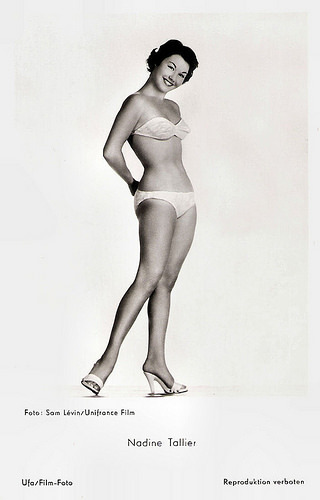
German postcard by Ufa, Berlin-Tempelhof, no. FK 3441. Photo: Sam Lévin / Unifrance Film.
Sexy French actress Nadine Tallier (1932) played various film roles from the late 1940s till the early 1960s. In 1962, she married banker Edmond Adolphe de Rothschild and then retired.
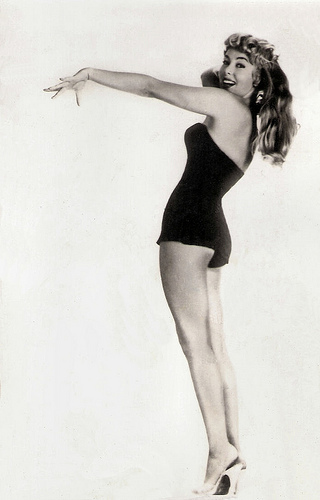
Yugoslavian postcard by Studio Sombor. Photo: Sam Lévin.
Belgian actress Dominique Wilms (1932) was the glamorous and sexy femme fatale of many French action films of the 1950s and 1960s, often opposite Eddie Constantine.
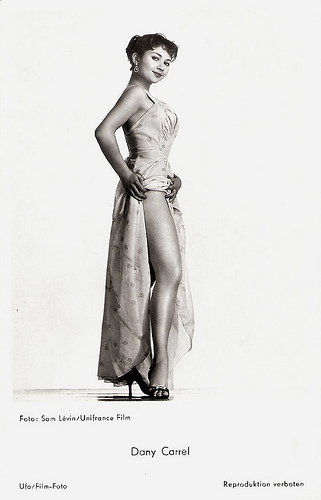
German postcard by Ufa, Berlin-Tempelhof, no. 3543. Photo: Sam Lévin / Unifrance Film.
French starlet Dany Carrel (1932) with her bob haircut of dark reddish hair, a pair of incredible oriental eyes, and friendly manners, was a welcome breath of sexy exoticism in the French cinema of the 1950s and 1960s. Dany played good-willed flirtatious girls in many melodramas and comedies, alongside top directors and stars.
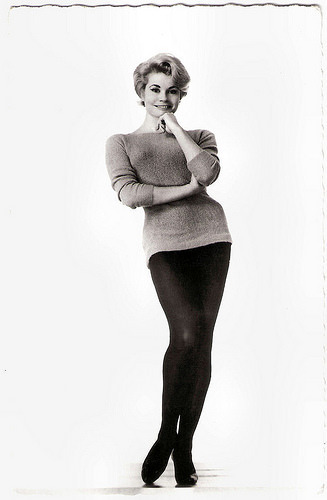
French postcard by Editions du Globe, Paris, no. 732. Photo: Sam Lévin.
Beautiful Noëlle Adam (1933) was a French dancer and actress. She frequently co-starred with comic star Louis de De Funes .
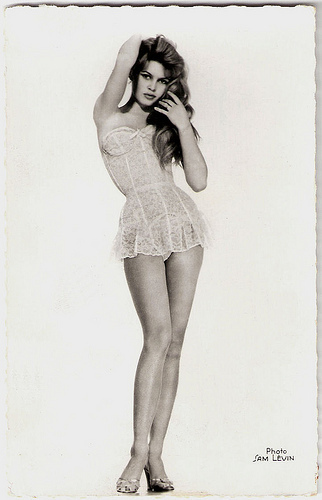
French postcard by Editions du Globe, Paris, no. 599. Photo: Sam Lévin, 1956.
Brigitte Bardot (1934) was the sex kitten of the European cinema. She was every man's idea of the girl he'd like to meet in Paris.

French postcard by Editions du Globe, Paris, no. 727. Photo: Sam Lévin.
French sex kitten Agnès Laurent (1938-2010) featured in a dozen European sex comedies in the late 1950s and early 1960s.
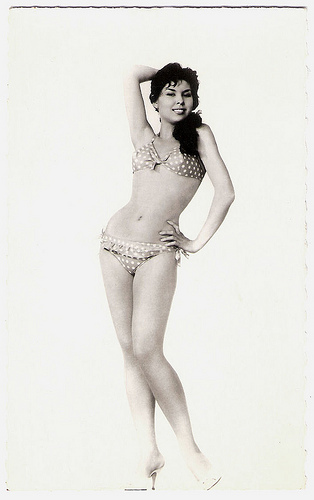
French postcard by Editions P.I., Paris, no. 892. Offered by les Carbones Korès 'Carboplane'. Photo: Sam Lévin.
French brunette Dominique Boschero (1934) is famous among cult film fans for her roles in dozens of Italian giallos and spaghetti westerns. The gorgeous actress appeared in a surprisingly large amount of films from the mid-1950s to the mid 1980s.
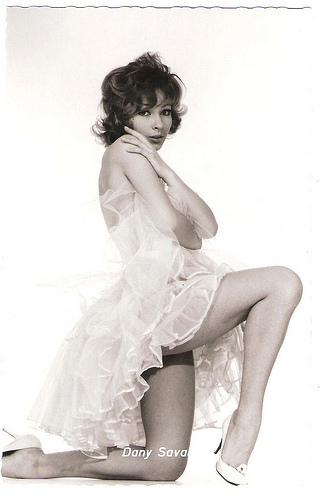
German postcard by Kolibri-Verlag, no. 1744.
Gorgeous French actress Dany Saval (1942) was the lithe and lovely leading lady in both fluffy comedies and thrillers of the late 1950s and early 1960s.
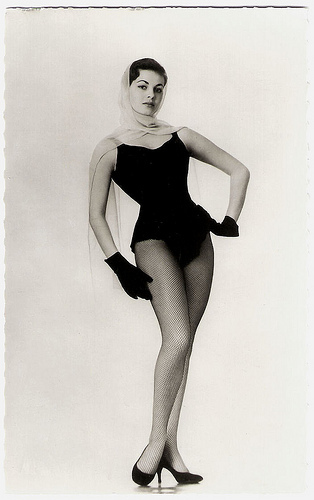
French postcard by Editions P.I., Paris, no. 937. Offered by Les Carbones Korès 'Carboplane'. Photo: Sam Lévin.
Entrancing, luscious-lipped French actress Michèle Mercier (1939) will always be remembered as seductive Angélique, ‘the Marquise of the Angels’.
Au revoir!

French postcard by Editions du Globe, Paris, no. 357. Photo: Lucienne Chevert.
Sex symbol Martine Carol (1920–1967) was one of the most beautiful women of the French cinema. During the early 1950s, she was a top box office draw as an elegant blonde seductress. Her private life was filled with turmoil including a suicide attempt, drug abuse, a kidnapping, and a mysterious death.

German postcard by Kunst und Bild, Berlin.
French actress, writer and director Cécile Aubry (1928-2010) was often seen as the predecessor of Brigitte Bardot as the French cinema's sex goddess. Her acting career was successful but brief: during the late 1940s through the mid-1950s.

French postcard by Editions du Globe, no. 617. Photo: Sam Lévin, Paris.
Pretty and petite actress Françoise Arnoul (1931) was in the early 1950s presented as the new French sex symbol but soon she would be overshadowed by the spectacular Brigitte Bardot . But, Arnoul had enough talent and range to forge a decent film career for herself.

German postcard by Ufa, Berlin-Tempelhof, no. FK 3441. Photo: Sam Lévin / Unifrance Film.
Sexy French actress Nadine Tallier (1932) played various film roles from the late 1940s till the early 1960s. In 1962, she married banker Edmond Adolphe de Rothschild and then retired.

Yugoslavian postcard by Studio Sombor. Photo: Sam Lévin.
Belgian actress Dominique Wilms (1932) was the glamorous and sexy femme fatale of many French action films of the 1950s and 1960s, often opposite Eddie Constantine.

German postcard by Ufa, Berlin-Tempelhof, no. 3543. Photo: Sam Lévin / Unifrance Film.
French starlet Dany Carrel (1932) with her bob haircut of dark reddish hair, a pair of incredible oriental eyes, and friendly manners, was a welcome breath of sexy exoticism in the French cinema of the 1950s and 1960s. Dany played good-willed flirtatious girls in many melodramas and comedies, alongside top directors and stars.

French postcard by Editions du Globe, Paris, no. 732. Photo: Sam Lévin.
Beautiful Noëlle Adam (1933) was a French dancer and actress. She frequently co-starred with comic star Louis de De Funes .

French postcard by Editions du Globe, Paris, no. 599. Photo: Sam Lévin, 1956.
Brigitte Bardot (1934) was the sex kitten of the European cinema. She was every man's idea of the girl he'd like to meet in Paris.

French postcard by Editions du Globe, Paris, no. 727. Photo: Sam Lévin.
French sex kitten Agnès Laurent (1938-2010) featured in a dozen European sex comedies in the late 1950s and early 1960s.

French postcard by Editions P.I., Paris, no. 892. Offered by les Carbones Korès 'Carboplane'. Photo: Sam Lévin.
French brunette Dominique Boschero (1934) is famous among cult film fans for her roles in dozens of Italian giallos and spaghetti westerns. The gorgeous actress appeared in a surprisingly large amount of films from the mid-1950s to the mid 1980s.

German postcard by Kolibri-Verlag, no. 1744.
Gorgeous French actress Dany Saval (1942) was the lithe and lovely leading lady in both fluffy comedies and thrillers of the late 1950s and early 1960s.

French postcard by Editions P.I., Paris, no. 937. Offered by Les Carbones Korès 'Carboplane'. Photo: Sam Lévin.
Entrancing, luscious-lipped French actress Michèle Mercier (1939) will always be remembered as seductive Angélique, ‘the Marquise of the Angels’.
Au revoir!
Published on June 23, 2016 22:00
June 22, 2016
Geraldine Chaplin
Versatile English-American actress Geraldine Chaplin (1944) is the daughter of Charlie Chaplin. Her breakthrough was her role as Omar Shariff’s wife in David Lean’s classic Doctor Zhivago (1965). She became an internationally respected actress with her appearances in several films by Robert Altman and her starring roles in nine films by her former partner, Spanish director Carlos Saura.
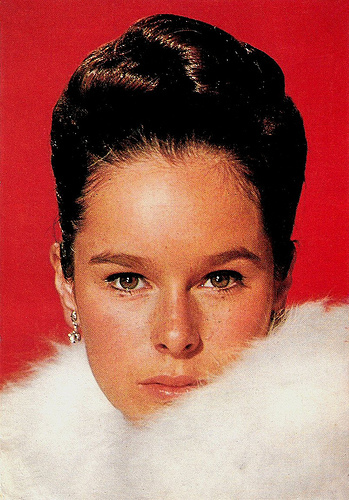
Spanish postcard by Postal Oscarcolor, no. 498.
Haunting Blue Eyes
Geraldine Leigh Chaplin was born in Santa Monica, California, in 1944. She was the fourth child of legendary actor/director Sir Charles Chaplin , and the first of eight children with his fourth and last wife, Oona O'Neill (daughter of famous playwright Eugene O'Neill and author Agnes Boulton).
Among her brothers and sisters are Christopher Chaplin, Eugene Chaplin, Michael Chaplin, Josephine Chaplin, and Victoria Chaplin. She is also the half sister of Sydney Chaplin, Charles Chaplin, Jr. and Norman Chaplin.
She spent her first eight years in Hollywood, but then moved with her family to Switzerland when her father was persecuted by the U.S. government for his political beliefs. There she was educated at a boarding school and became fluent in French and Spanish. The latter she later demonstrated in many Spanish films.
When Chaplin was eight years old, she appeared uncredited in the opening scene of her father's film Limelight (Charles Chaplin, 1952). Later she attended the Royal Ballet Academy in London. When her dream of becoming a ballet dancer ended, she followed her father into the acting profession. She would play a small role in her father's last film, A Countess From Hong Kong (Charles Chaplin, 1967) starring Marlon Brando and Sophia Loren.
British director David Lean had discovered her earlier while she was dancing in Paris and he chose her to play Tonya Gromeko, the main character's wife in his film Doctor Zhivago (David Lean, 1965). Based on the Nobel Prize-winning novel by Boris Pasternak, Doctor Zhivago covers the years prior to, during, and after the Russian Revolution, as seen through the eyes of poet/physician Yuri Zhivago (Omar Sharif).
At AllMovie , Sandra Brennan describes her as many people remember her from this film: a “diminutive, willowy, and offbeat beauty with haunting blue eyes”. The film received five Oscars, and Chaplin was nominated for a Golden Globe as Most Promising Female Newcomer.
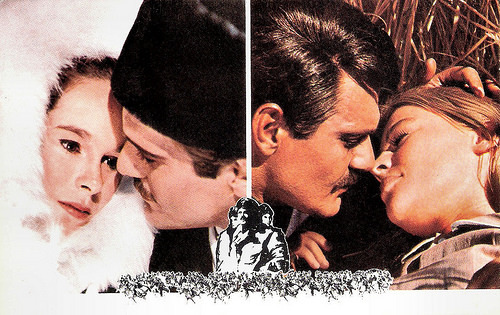
American postcard. Photo: MGM. Photo: publicity stills for Dr. Zhivago (David Lean, 1965) with Omar Sharif and Julie Christie .
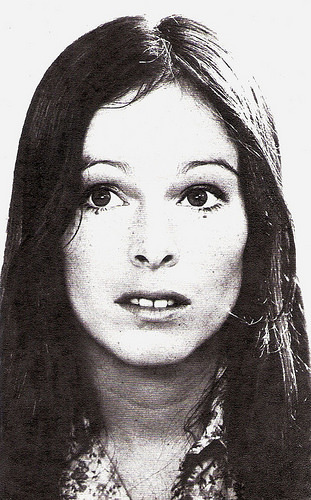
Hungarian collectors card by Atheneum, 1974.
Long Romance
Much of Doctor Zhivago was shot in Spain and it was there that Geraldine Chaplin began a long romance with Spanish director Carlos Saura. A year later she worked for the first time with him at Peppermint Frappé (Carlos Saura, 1967), in which she played a double role.
Chaplin starred in eight more films by Saura, including Ana y los Lobos/Anna And The Wolves (Carlos Saura, 1972), the powerful psychological drama Cría cuervos/Raise Ravens (Carlos Saura, 1976) as the mother of Ana Torrent, Elisa, vida mía/Elisa, My Life (Carlos Saura, 1977) as the daughter of Fernando Rey, and Mama Cumple Cien Años/Mama Turns a Hundred (Carlos Saura, 1979).
She has subsequently worked with some of Europe's finest directors. She played the Queen in Richard Lester's adaptation of Alexandre Dumas classic The Three Musketeers (Richard Lester, 1973) and the sequel The Four Musketeers (Richard Lester, 1975) featuring Michael York, Oliver Reed, Richard Chamberlain and Frank Finlay.
She played a pirate opposite Bernadette Lafont in the experimental film Noroit/Northwind (Jacques Rivette, 1976). In France she also appeared in Mais Ou Est Donc Ornicar (Bertrand van Effenterre, 1979) and in Le Voyage en Douce/Travels on the Sky (Michel Deville, 1980) as the sister of Dominique Sanda .
During the 1970s, Chaplin also appeared in several films of American director of Robert Altman, such as Buffalo Bill and the Indians, or Sitting Bull's History Lesson (1976) and A Wedding (1978). For her role as the chatty, shallow BBC reporter Opal in his Nashville (Robert Altman, 1975) she was once more nominated for a Golden Globe, this time as Best Supporting Actress. She received a BAFTA nomination for her role in Welcome to L.A. (1976), directed by Alan Rudolph, a protege and assistant director of Robert Altman.
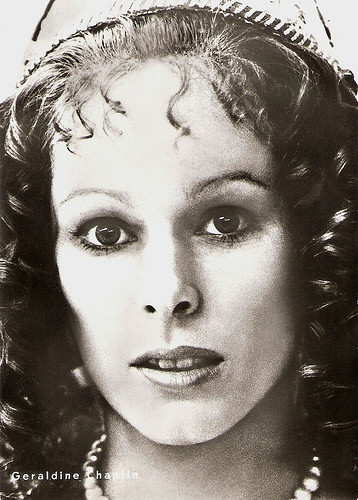
East-German postcard by VEB Progress Film-Vertrieb, Berlin, no. 65/75. Photo: Cinerama. Publicity still for The Three Musketeers (Richard Lester, 1973) with Chaplin as Queen Anna.
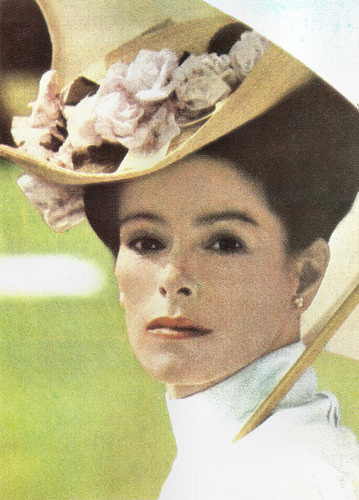
Romanian postcard by Casa Filmului Acin. Photo: publicity still for the TV film The House of Mirth (Adrian Hall, 1981).
Best Supporting Actress
Geraldine Chaplin liked to play character parts and appeared in such successful productions as the Agatha Christie mystery The Mirror Crack'd (Guy Hamilton, 1980) with Angela Lansbury as Miss Marple, the French epic Les Uns et les autres/Bolero (Claude Lelouch, 1981) with Robert Hossein , La Vie Est Un Roman/Life Is a Bed of Roses (Alain Resnais, 1983) with Vittorio Gassman , and Heartburn (Nora Ephron, 1986) starring Meryl Streep and Jack Nicholson.
In 1992, she played the role of her own grandmother, Hannah Chaplin, in the biographical film about her father, Chaplin (Richard Attenborough, 1992). It resulted in her third Golden Globe Nomination, as Best Supporting Actress. In the film, she is also briefly depicted as an eight-year-old girl in a scene set in September 1952. Another highlight was her part as Winona Ryder's mother in The Age of Innocence (Martin Scorsese, 1993).
In addition to her busy film career, Chaplin also appeared on-stage and in television miniseries such as Gulliver's Travels (Charles Sturridge, 1996), as Mother Theresa in Mother Teresa: In the Name of God's Poor (Kevin Connor, 1997), and Mary, Mother of Jesus (Kevin Connor, 1999) with Pernilla August and Christian Bale. William Brailsford of The Washington Times noted about her portrayal of Mother Theresa: "Miss Chaplin gives a convincing performance as Mother Teresa, imitating her soft voice and her awkward yet charming mannerisms and re-creating that aura of piety that surrounded the 'saint of the gutters'. This remarkable actress has us in the palm of her hands early on, and she never lets go."
Nowadays, Geraldine Chaplin is still very active in the cinema. Among her more recent films are the Spanish-Mexican horror film El Orfanato/The Orphanage (Juan Antonio Bayona, 2007), produced by Guillermo del Toro, the Italian bittersweet romantic drama Parlami d'amore/Let's Talk About Love (Silvio Muccino, 2008) and the horror film The Wolfman (Joe Johnston, 2010) starring Benicio Del Toro and Anthony Hopkins.
In 2014, Chaplin was awarded as Best Actress at the Havana Film Festival for her part as an old lesbian in the Dominican drama Dólares de Arena/Sand Dollars (Israel Cárdenas, Laura Amelia Guzmán, 2014). She also appeared alongside Salma Hayek in the French drama Americano (Mathieu Demy, 2011), and with Jane Fonda in the French-German comedy Et si on vivait tous ensemble?/All Together (Stéphane Robelin, 2011). She also reunited with director Juan Antonio Bayona for the award winning disaster drama Lo Imposible/The Impossible (2012) starring Naomi Watts and Ewan McGregor, and she will return in his upcoming Spanish-British fantasy drama A Monster Calls (2016) featuring Liam Neeson as the Monster.
Geraldine Chaplin and Carlos Saura had a twelve-year relationship. Later, Chilean cinematographer Patricio Castilla became her longtime companion. They married in 2006. She has two children, Shane (1974), by Saura, and Oona (1986), by Castilla. Oona is also an actress, best known for playing the role of Talisa Maegyr in HBO's hit series Game of Thrones. Geraldine Chaplin lives much of her time in Miami, Florida at her home next to the beach. In addition to her home in Miami, she also lives alternately between Madrid and Switzerland.
Trailer Doctor Zhivago (1965). Source: ccorujo (YouTube).
Trailer Cría cuervos/Raise Ravens (1976). Source: hbh2046 (YouTube).
Trailer Chaplin (1992). Source: prgwbtd (YouTube).
Trailer Sand Dollars (2014). Source: OfficialBGP (YouTube).
Sources: Sandra Brennan (AllMovie), (IMDb), Wikipedia and .

Spanish postcard by Postal Oscarcolor, no. 498.
Haunting Blue Eyes
Geraldine Leigh Chaplin was born in Santa Monica, California, in 1944. She was the fourth child of legendary actor/director Sir Charles Chaplin , and the first of eight children with his fourth and last wife, Oona O'Neill (daughter of famous playwright Eugene O'Neill and author Agnes Boulton).
Among her brothers and sisters are Christopher Chaplin, Eugene Chaplin, Michael Chaplin, Josephine Chaplin, and Victoria Chaplin. She is also the half sister of Sydney Chaplin, Charles Chaplin, Jr. and Norman Chaplin.
She spent her first eight years in Hollywood, but then moved with her family to Switzerland when her father was persecuted by the U.S. government for his political beliefs. There she was educated at a boarding school and became fluent in French and Spanish. The latter she later demonstrated in many Spanish films.
When Chaplin was eight years old, she appeared uncredited in the opening scene of her father's film Limelight (Charles Chaplin, 1952). Later she attended the Royal Ballet Academy in London. When her dream of becoming a ballet dancer ended, she followed her father into the acting profession. She would play a small role in her father's last film, A Countess From Hong Kong (Charles Chaplin, 1967) starring Marlon Brando and Sophia Loren.
British director David Lean had discovered her earlier while she was dancing in Paris and he chose her to play Tonya Gromeko, the main character's wife in his film Doctor Zhivago (David Lean, 1965). Based on the Nobel Prize-winning novel by Boris Pasternak, Doctor Zhivago covers the years prior to, during, and after the Russian Revolution, as seen through the eyes of poet/physician Yuri Zhivago (Omar Sharif).
At AllMovie , Sandra Brennan describes her as many people remember her from this film: a “diminutive, willowy, and offbeat beauty with haunting blue eyes”. The film received five Oscars, and Chaplin was nominated for a Golden Globe as Most Promising Female Newcomer.

American postcard. Photo: MGM. Photo: publicity stills for Dr. Zhivago (David Lean, 1965) with Omar Sharif and Julie Christie .

Hungarian collectors card by Atheneum, 1974.
Long Romance
Much of Doctor Zhivago was shot in Spain and it was there that Geraldine Chaplin began a long romance with Spanish director Carlos Saura. A year later she worked for the first time with him at Peppermint Frappé (Carlos Saura, 1967), in which she played a double role.
Chaplin starred in eight more films by Saura, including Ana y los Lobos/Anna And The Wolves (Carlos Saura, 1972), the powerful psychological drama Cría cuervos/Raise Ravens (Carlos Saura, 1976) as the mother of Ana Torrent, Elisa, vida mía/Elisa, My Life (Carlos Saura, 1977) as the daughter of Fernando Rey, and Mama Cumple Cien Años/Mama Turns a Hundred (Carlos Saura, 1979).
She has subsequently worked with some of Europe's finest directors. She played the Queen in Richard Lester's adaptation of Alexandre Dumas classic The Three Musketeers (Richard Lester, 1973) and the sequel The Four Musketeers (Richard Lester, 1975) featuring Michael York, Oliver Reed, Richard Chamberlain and Frank Finlay.
She played a pirate opposite Bernadette Lafont in the experimental film Noroit/Northwind (Jacques Rivette, 1976). In France she also appeared in Mais Ou Est Donc Ornicar (Bertrand van Effenterre, 1979) and in Le Voyage en Douce/Travels on the Sky (Michel Deville, 1980) as the sister of Dominique Sanda .
During the 1970s, Chaplin also appeared in several films of American director of Robert Altman, such as Buffalo Bill and the Indians, or Sitting Bull's History Lesson (1976) and A Wedding (1978). For her role as the chatty, shallow BBC reporter Opal in his Nashville (Robert Altman, 1975) she was once more nominated for a Golden Globe, this time as Best Supporting Actress. She received a BAFTA nomination for her role in Welcome to L.A. (1976), directed by Alan Rudolph, a protege and assistant director of Robert Altman.

East-German postcard by VEB Progress Film-Vertrieb, Berlin, no. 65/75. Photo: Cinerama. Publicity still for The Three Musketeers (Richard Lester, 1973) with Chaplin as Queen Anna.

Romanian postcard by Casa Filmului Acin. Photo: publicity still for the TV film The House of Mirth (Adrian Hall, 1981).
Best Supporting Actress
Geraldine Chaplin liked to play character parts and appeared in such successful productions as the Agatha Christie mystery The Mirror Crack'd (Guy Hamilton, 1980) with Angela Lansbury as Miss Marple, the French epic Les Uns et les autres/Bolero (Claude Lelouch, 1981) with Robert Hossein , La Vie Est Un Roman/Life Is a Bed of Roses (Alain Resnais, 1983) with Vittorio Gassman , and Heartburn (Nora Ephron, 1986) starring Meryl Streep and Jack Nicholson.
In 1992, she played the role of her own grandmother, Hannah Chaplin, in the biographical film about her father, Chaplin (Richard Attenborough, 1992). It resulted in her third Golden Globe Nomination, as Best Supporting Actress. In the film, she is also briefly depicted as an eight-year-old girl in a scene set in September 1952. Another highlight was her part as Winona Ryder's mother in The Age of Innocence (Martin Scorsese, 1993).
In addition to her busy film career, Chaplin also appeared on-stage and in television miniseries such as Gulliver's Travels (Charles Sturridge, 1996), as Mother Theresa in Mother Teresa: In the Name of God's Poor (Kevin Connor, 1997), and Mary, Mother of Jesus (Kevin Connor, 1999) with Pernilla August and Christian Bale. William Brailsford of The Washington Times noted about her portrayal of Mother Theresa: "Miss Chaplin gives a convincing performance as Mother Teresa, imitating her soft voice and her awkward yet charming mannerisms and re-creating that aura of piety that surrounded the 'saint of the gutters'. This remarkable actress has us in the palm of her hands early on, and she never lets go."
Nowadays, Geraldine Chaplin is still very active in the cinema. Among her more recent films are the Spanish-Mexican horror film El Orfanato/The Orphanage (Juan Antonio Bayona, 2007), produced by Guillermo del Toro, the Italian bittersweet romantic drama Parlami d'amore/Let's Talk About Love (Silvio Muccino, 2008) and the horror film The Wolfman (Joe Johnston, 2010) starring Benicio Del Toro and Anthony Hopkins.
In 2014, Chaplin was awarded as Best Actress at the Havana Film Festival for her part as an old lesbian in the Dominican drama Dólares de Arena/Sand Dollars (Israel Cárdenas, Laura Amelia Guzmán, 2014). She also appeared alongside Salma Hayek in the French drama Americano (Mathieu Demy, 2011), and with Jane Fonda in the French-German comedy Et si on vivait tous ensemble?/All Together (Stéphane Robelin, 2011). She also reunited with director Juan Antonio Bayona for the award winning disaster drama Lo Imposible/The Impossible (2012) starring Naomi Watts and Ewan McGregor, and she will return in his upcoming Spanish-British fantasy drama A Monster Calls (2016) featuring Liam Neeson as the Monster.
Geraldine Chaplin and Carlos Saura had a twelve-year relationship. Later, Chilean cinematographer Patricio Castilla became her longtime companion. They married in 2006. She has two children, Shane (1974), by Saura, and Oona (1986), by Castilla. Oona is also an actress, best known for playing the role of Talisa Maegyr in HBO's hit series Game of Thrones. Geraldine Chaplin lives much of her time in Miami, Florida at her home next to the beach. In addition to her home in Miami, she also lives alternately between Madrid and Switzerland.
Trailer Doctor Zhivago (1965). Source: ccorujo (YouTube).
Trailer Cría cuervos/Raise Ravens (1976). Source: hbh2046 (YouTube).
Trailer Chaplin (1992). Source: prgwbtd (YouTube).
Trailer Sand Dollars (2014). Source: OfficialBGP (YouTube).
Sources: Sandra Brennan (AllMovie), (IMDb), Wikipedia and .
Published on June 22, 2016 22:00
Paul van Yperen's Blog
- Paul van Yperen's profile
- 13 followers
Paul van Yperen isn't a Goodreads Author
(yet),
but they
do have a blog,
so here are some recent posts imported from
their feed.



